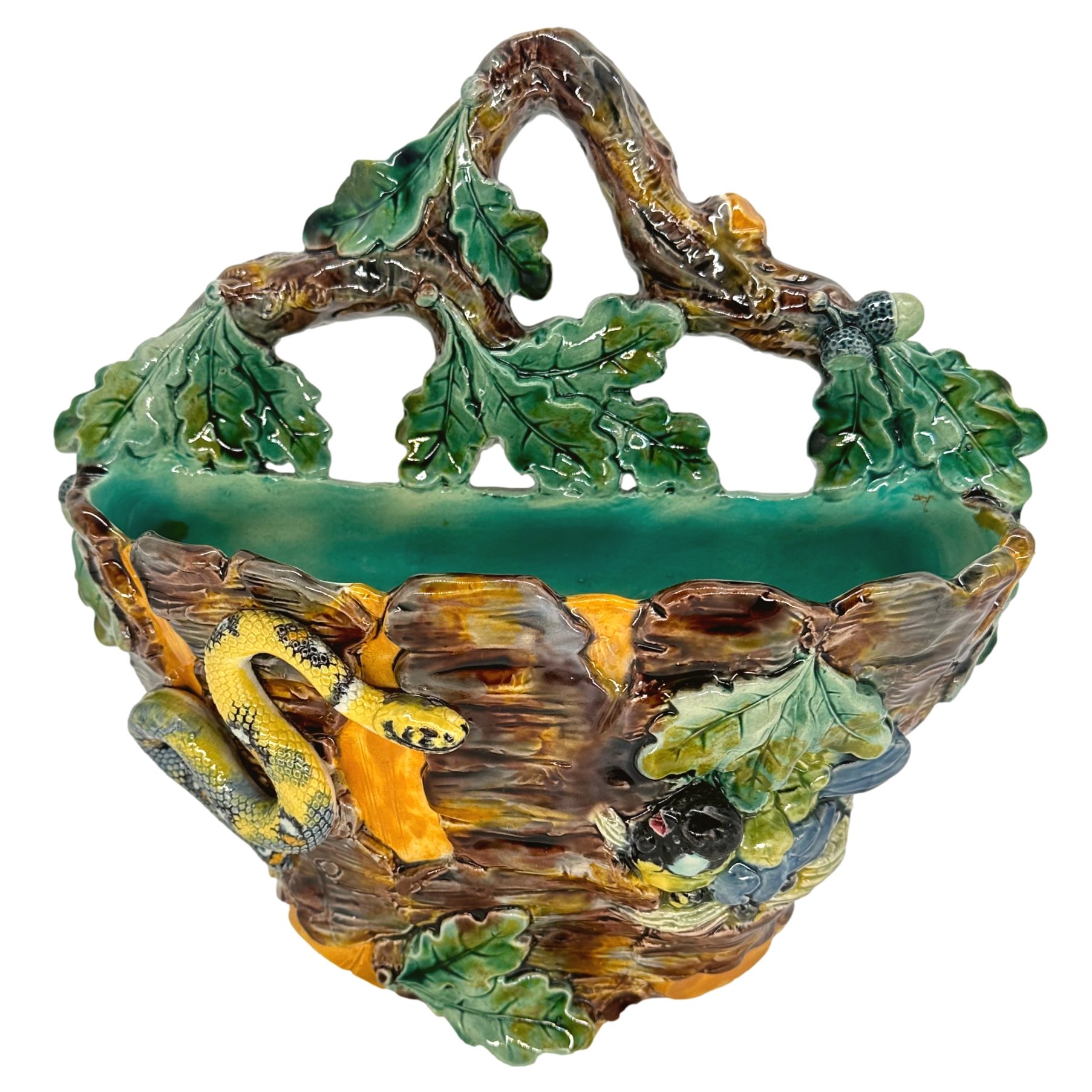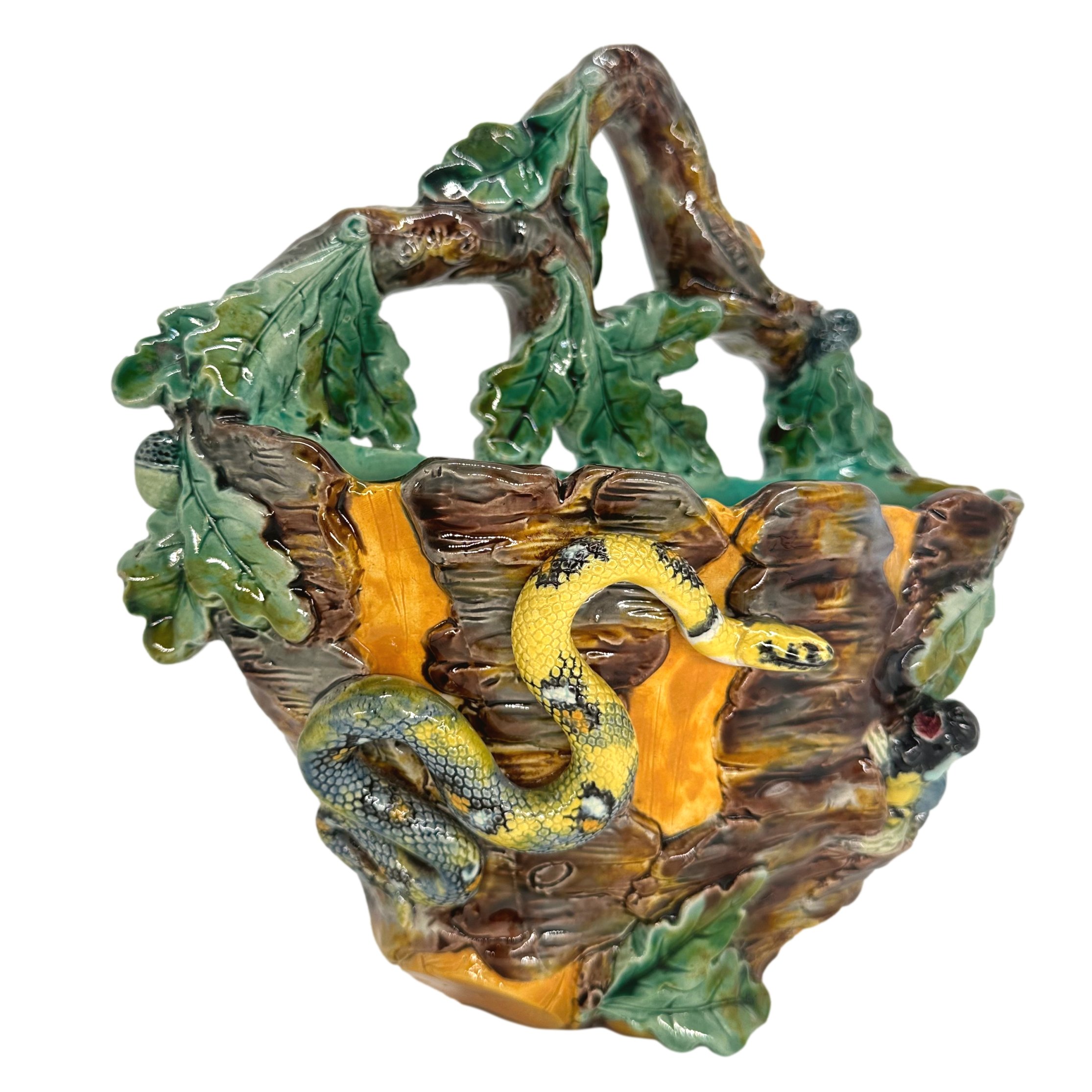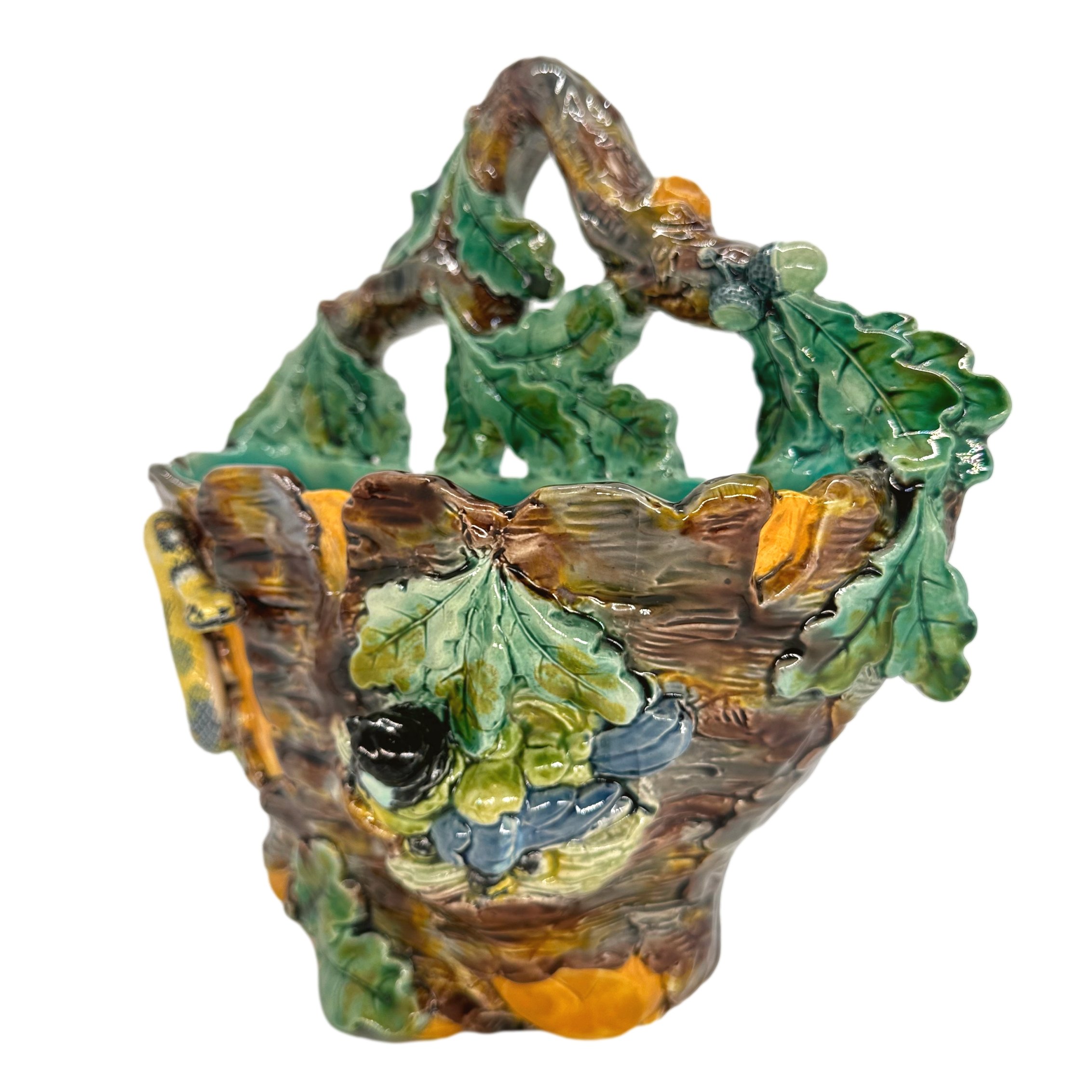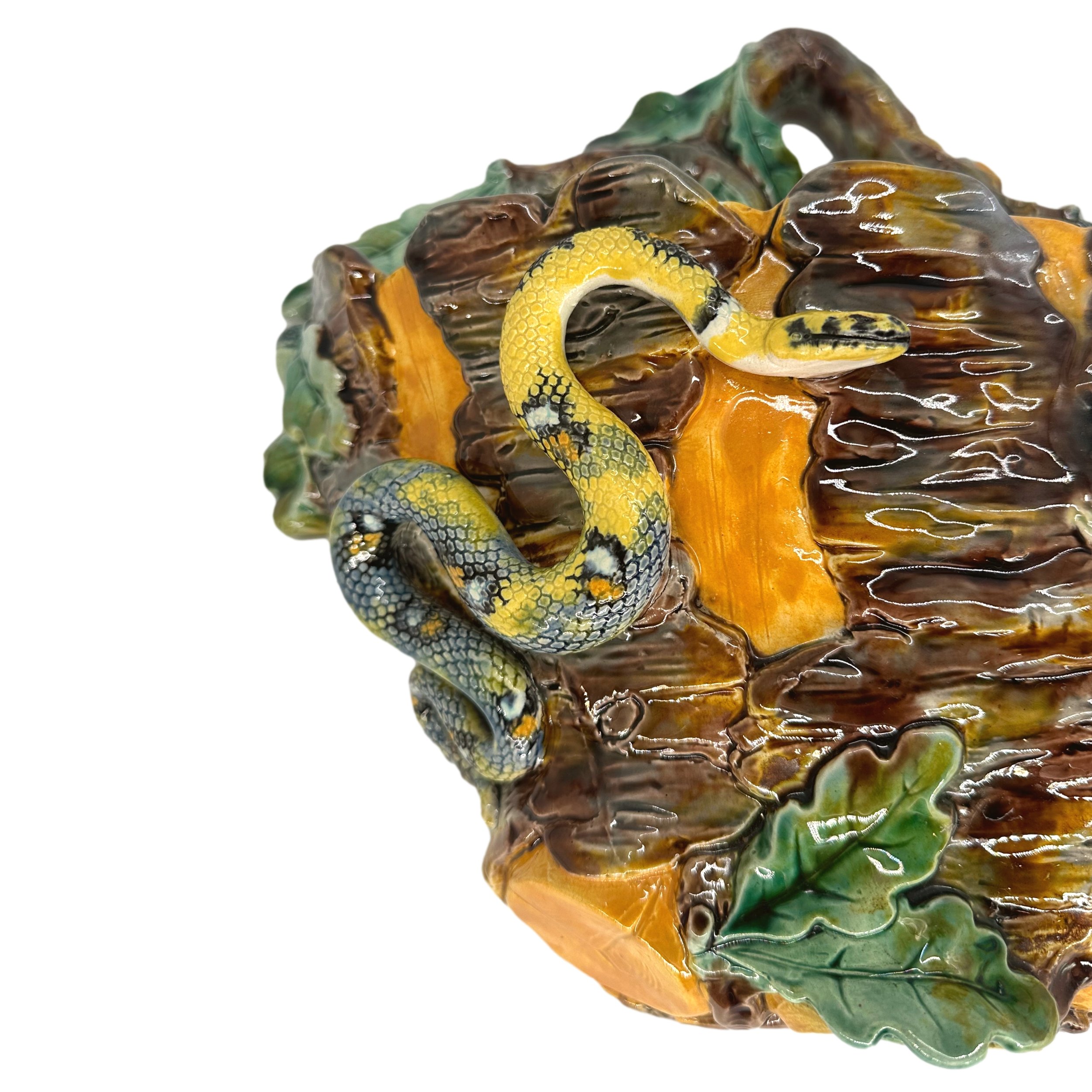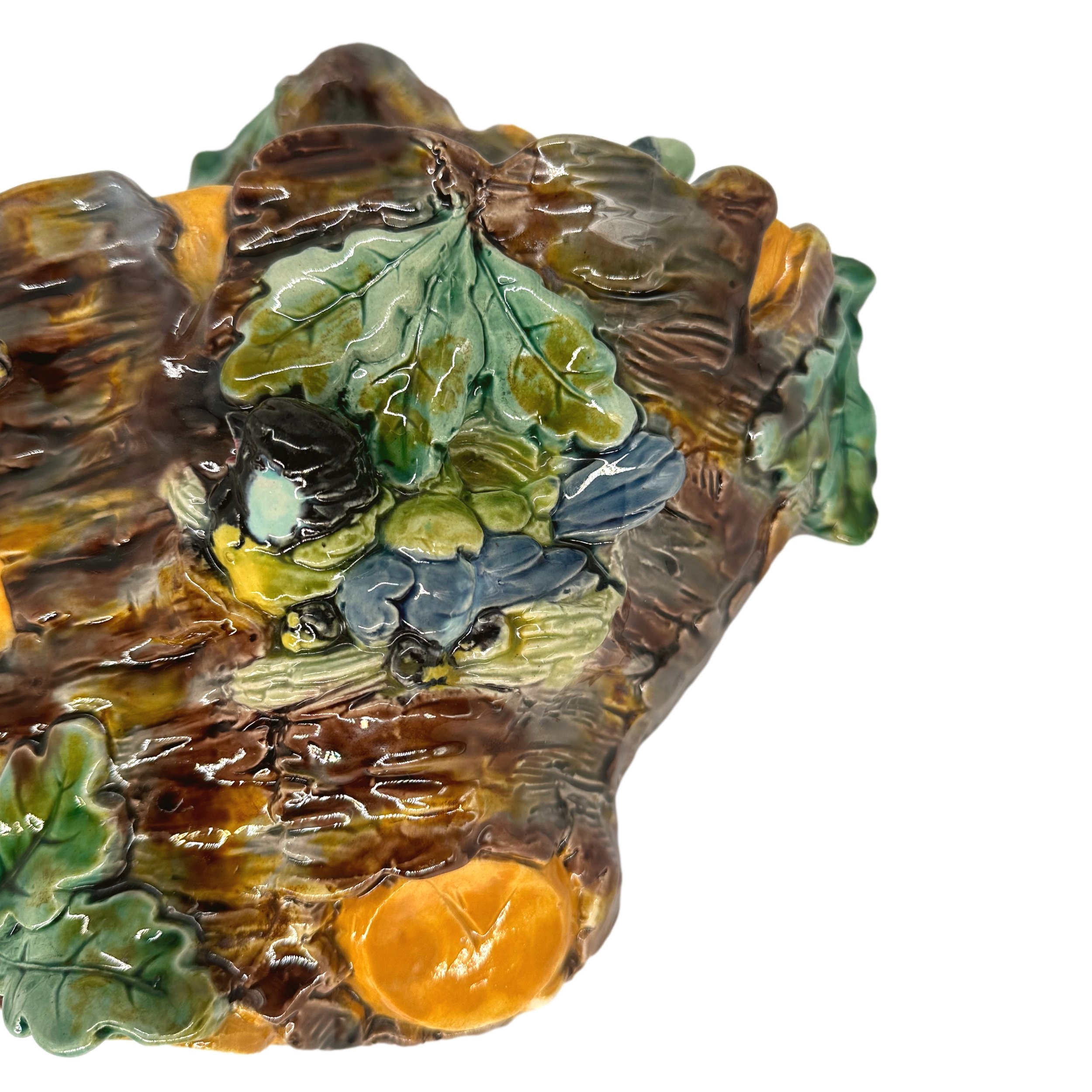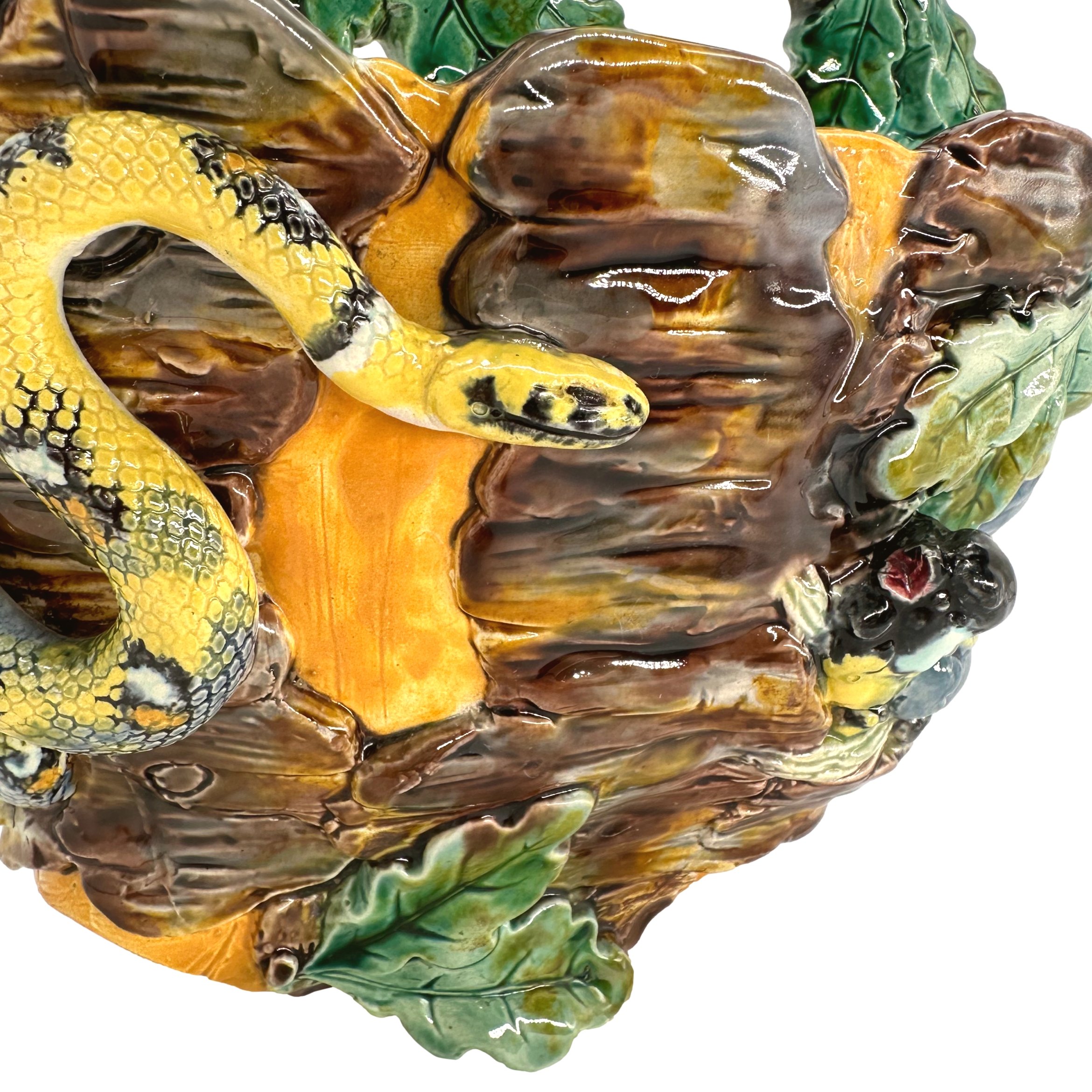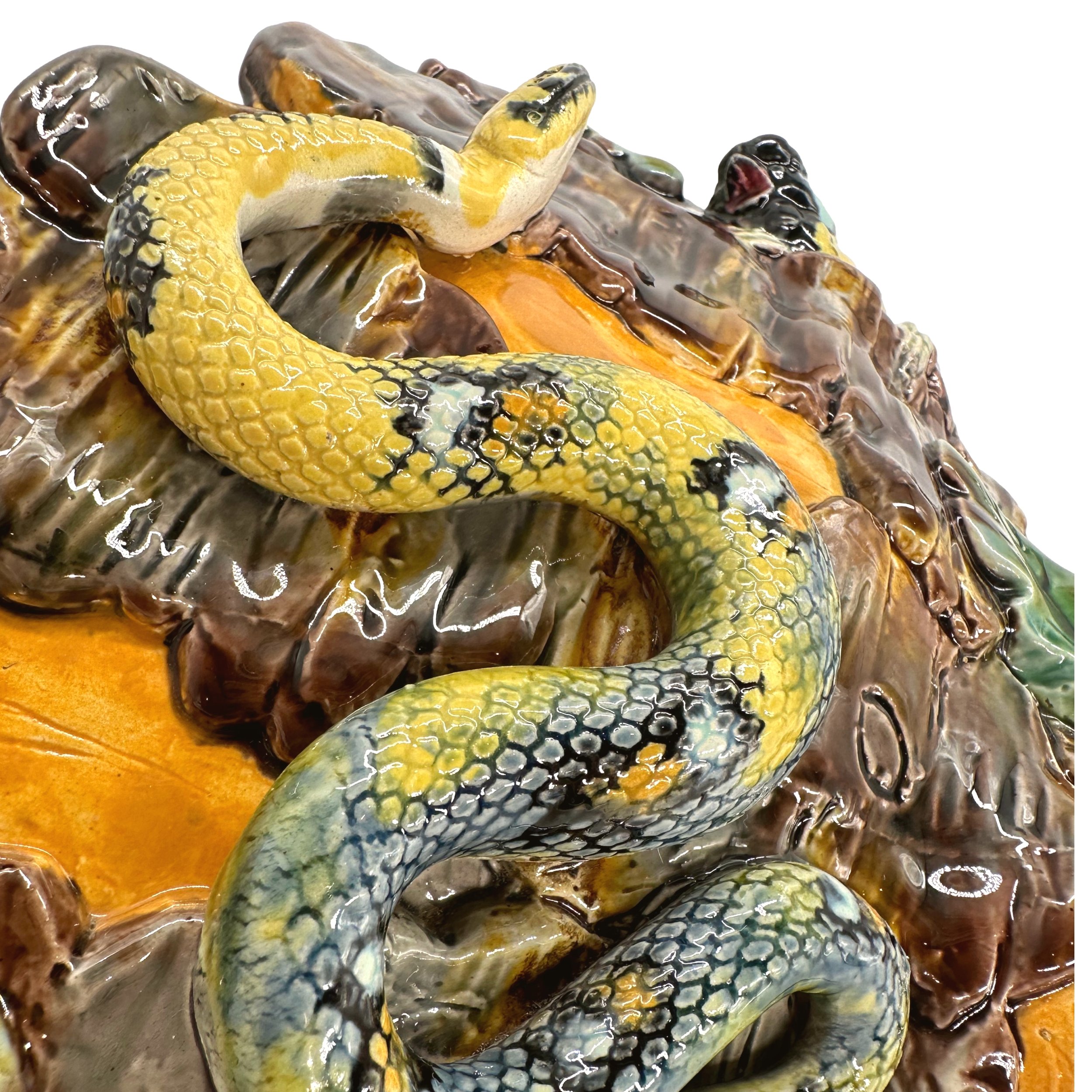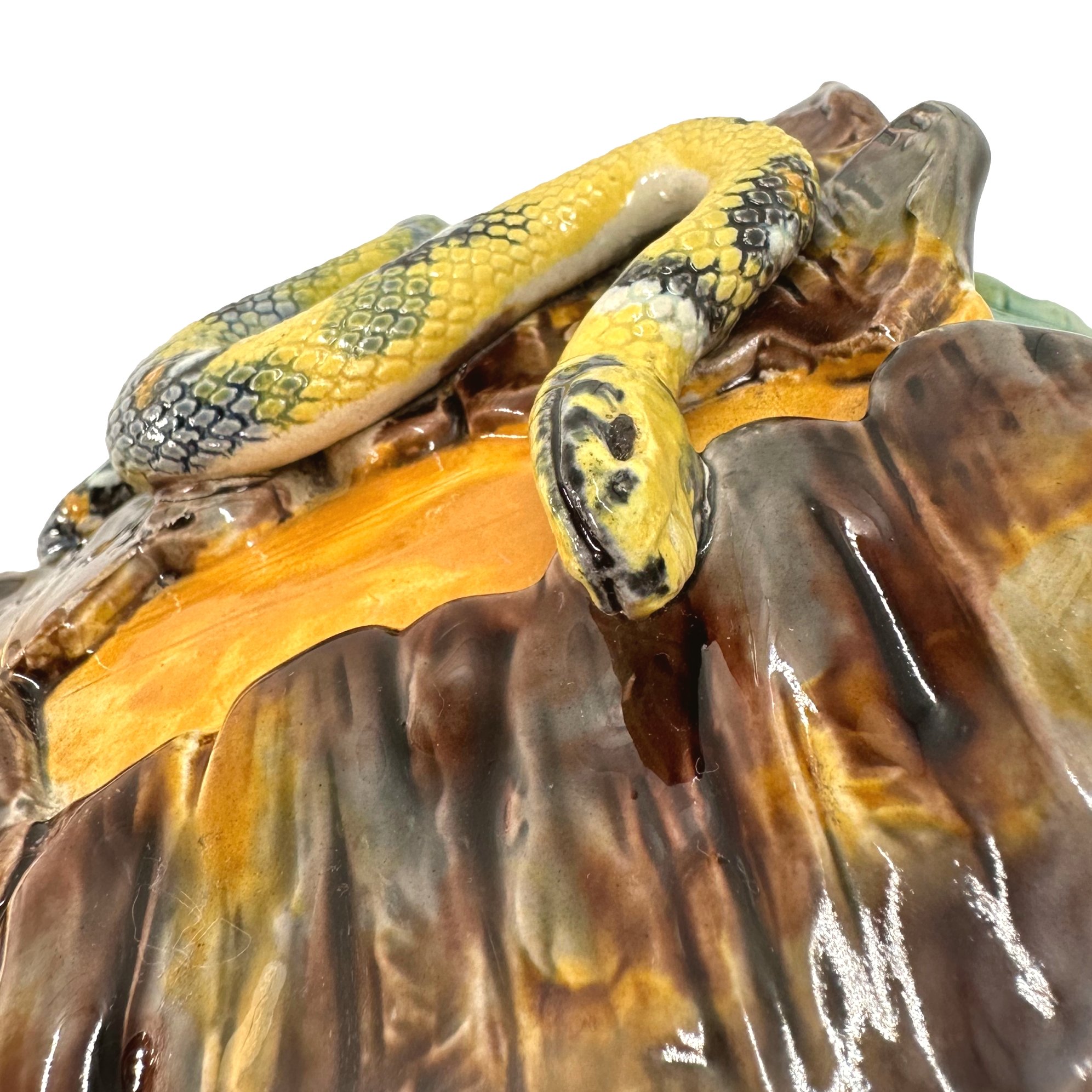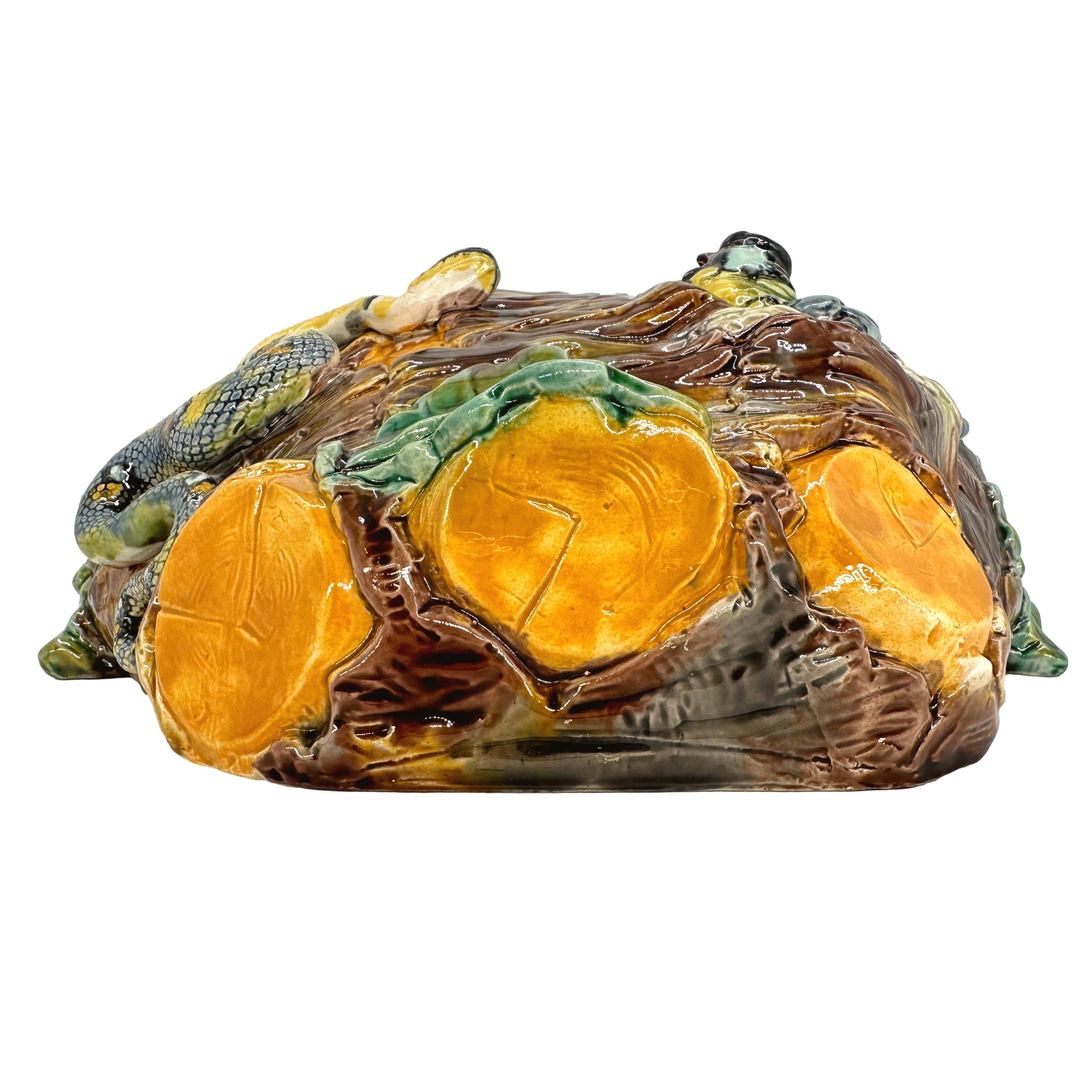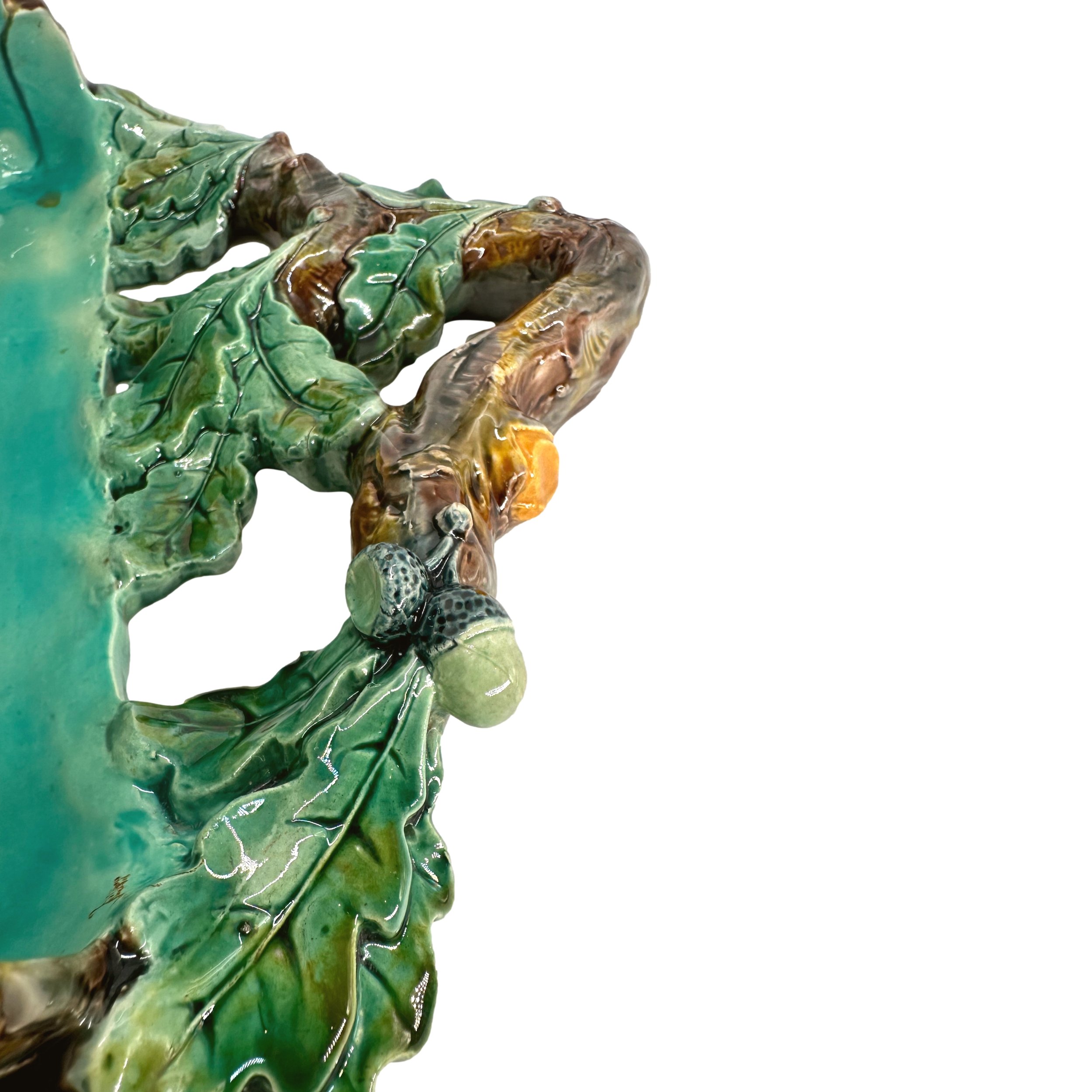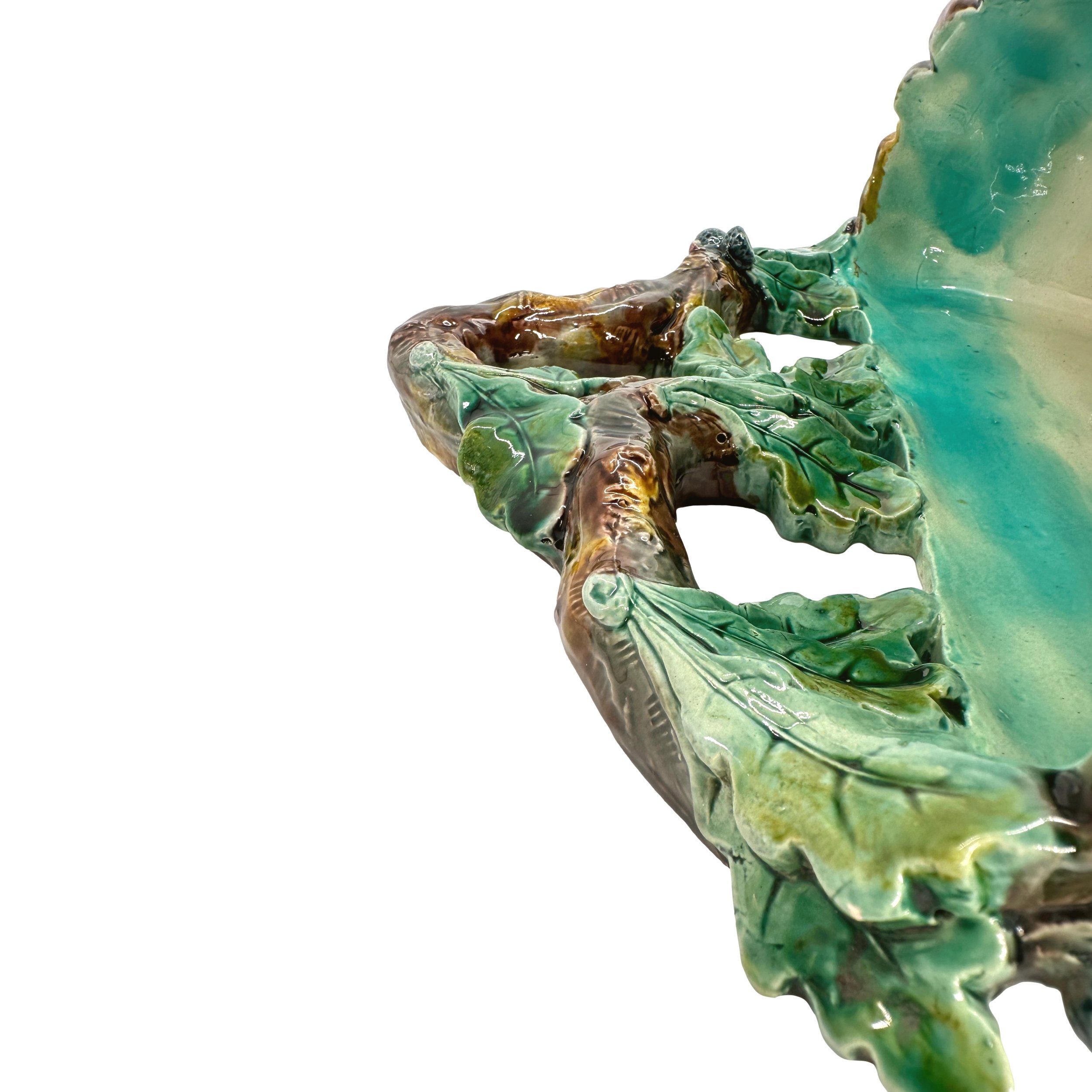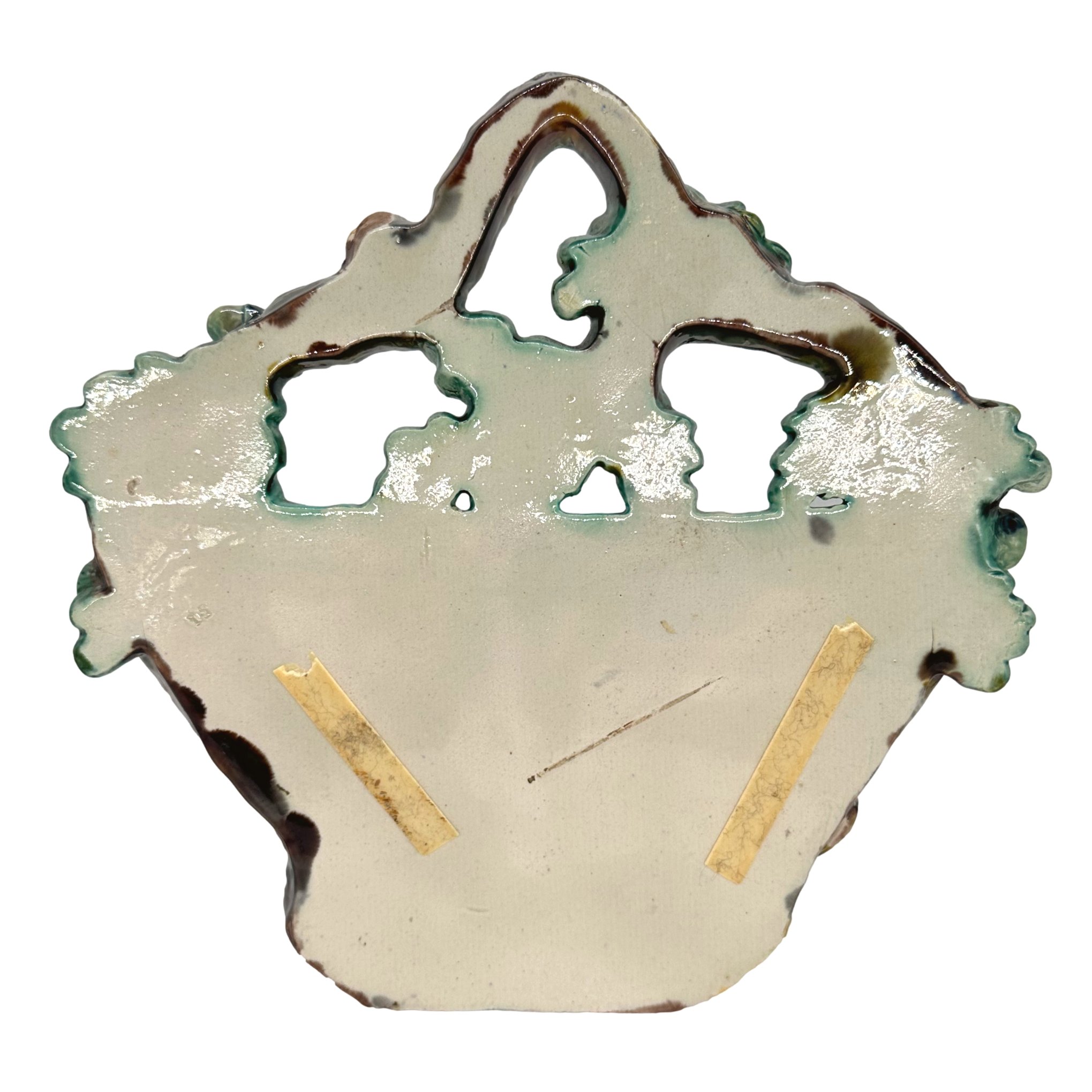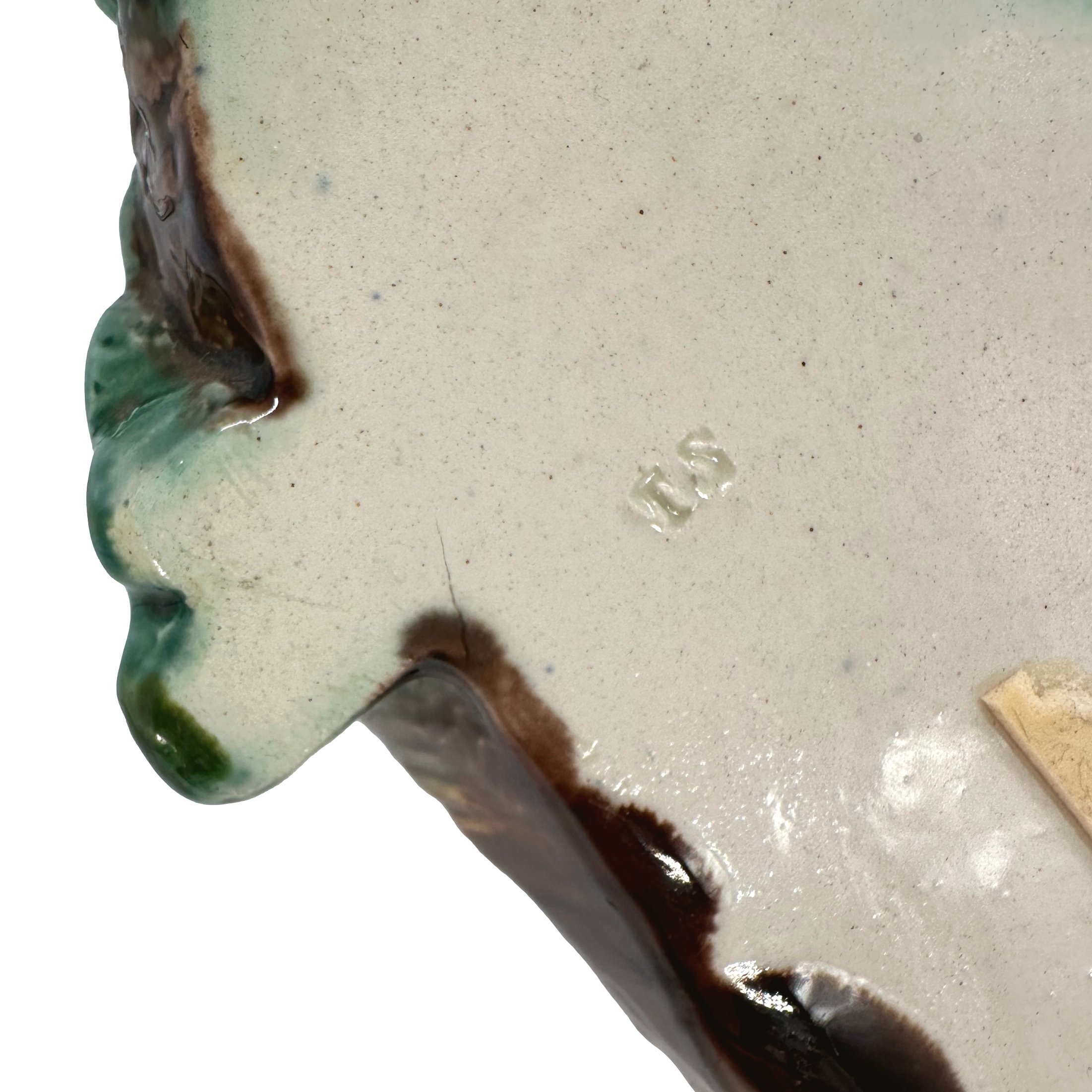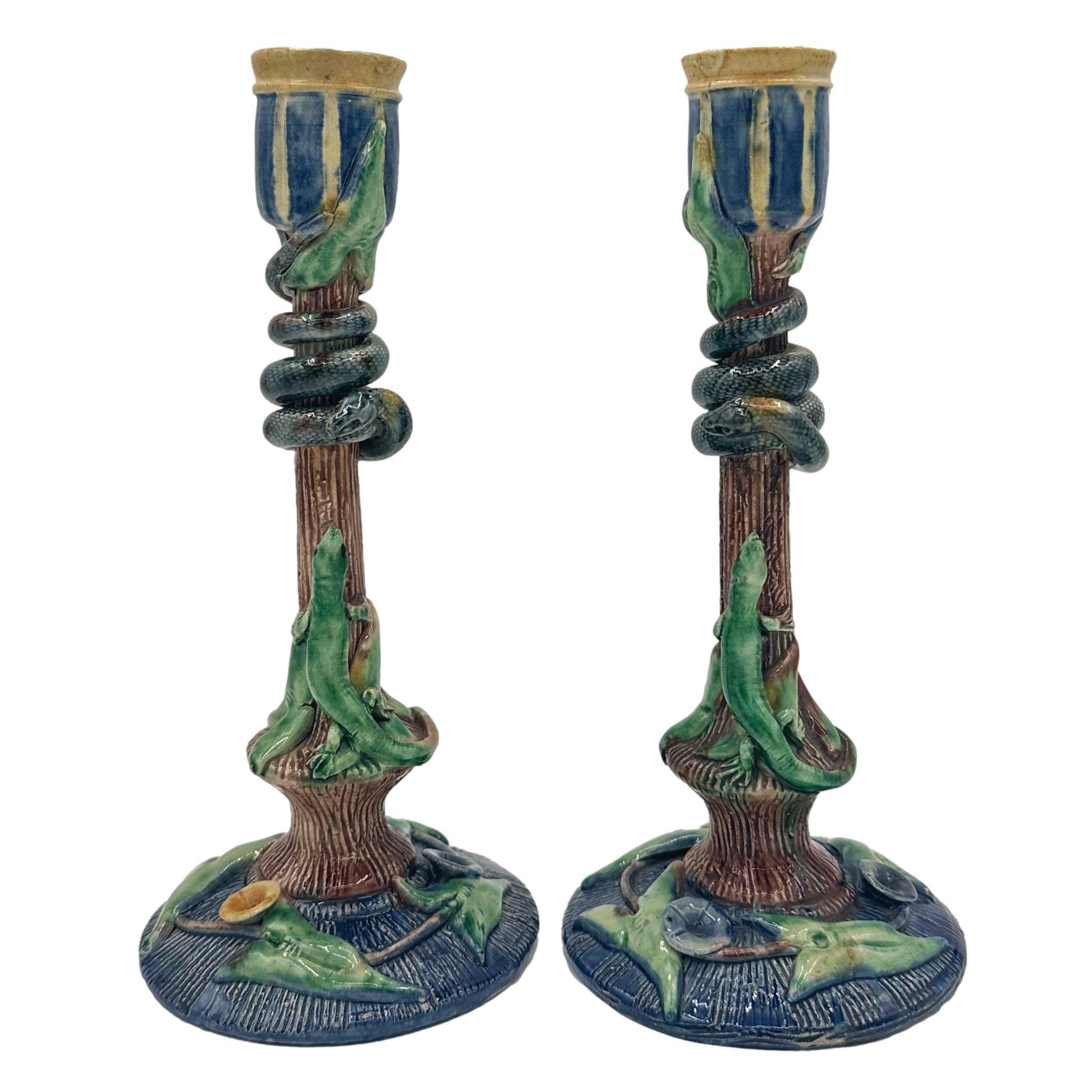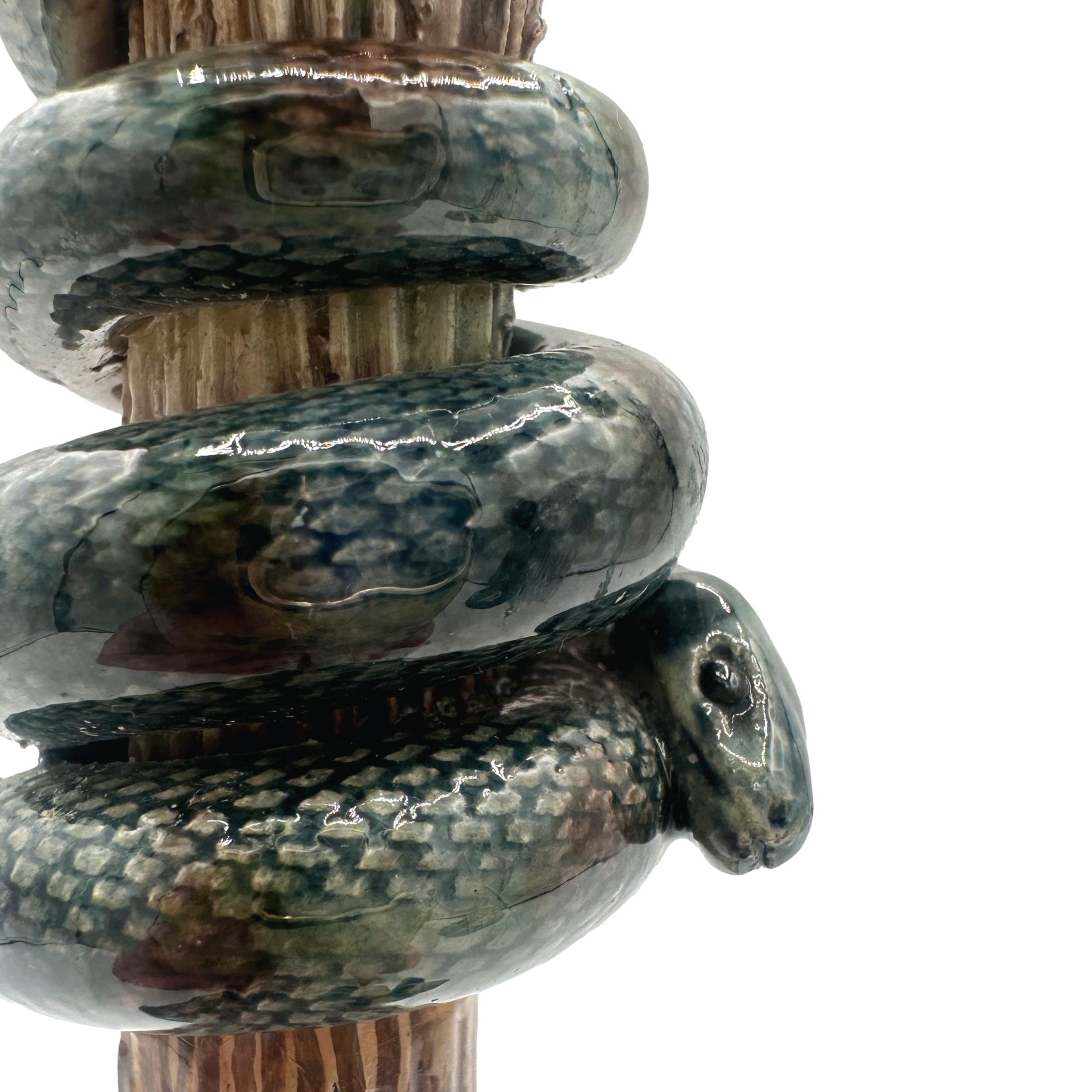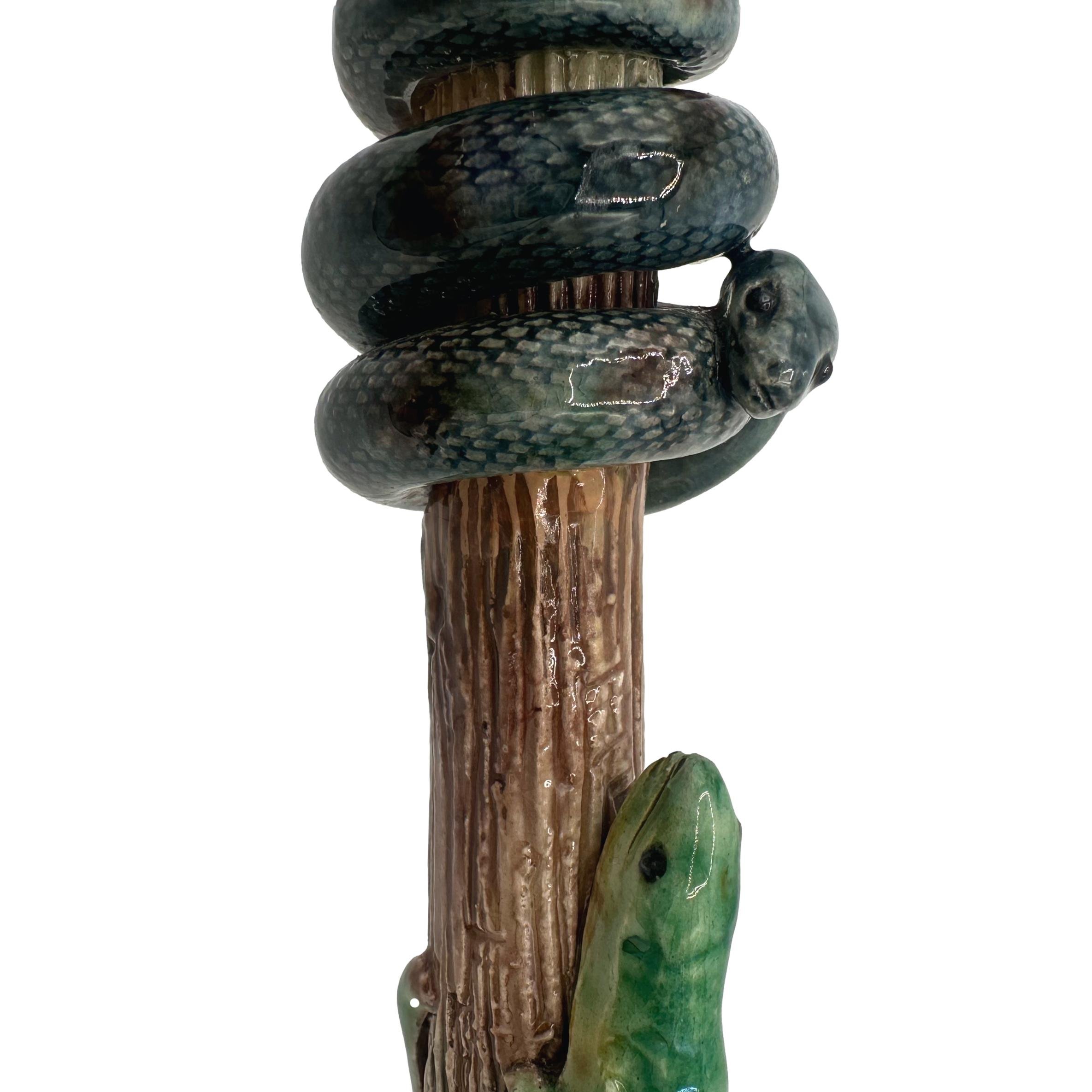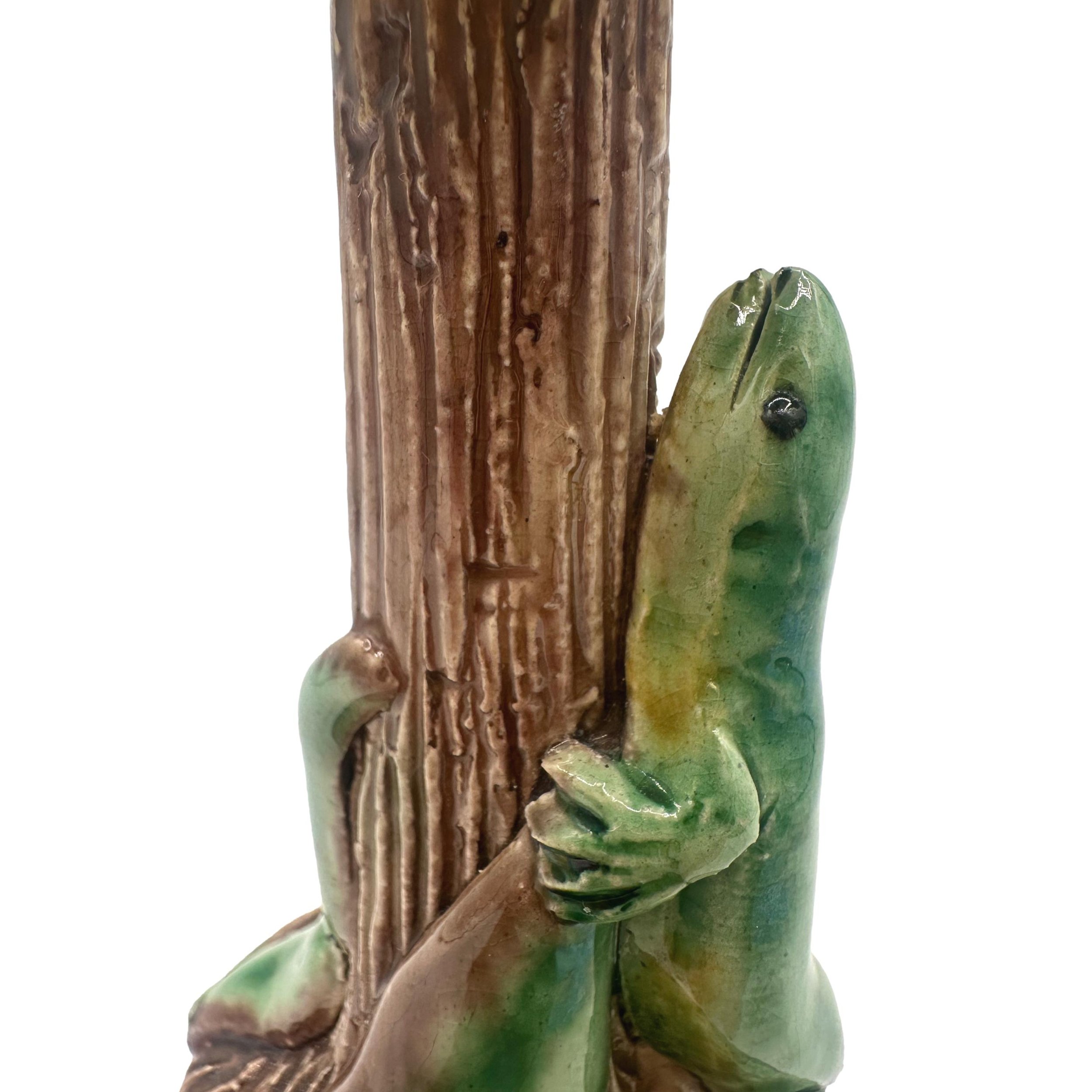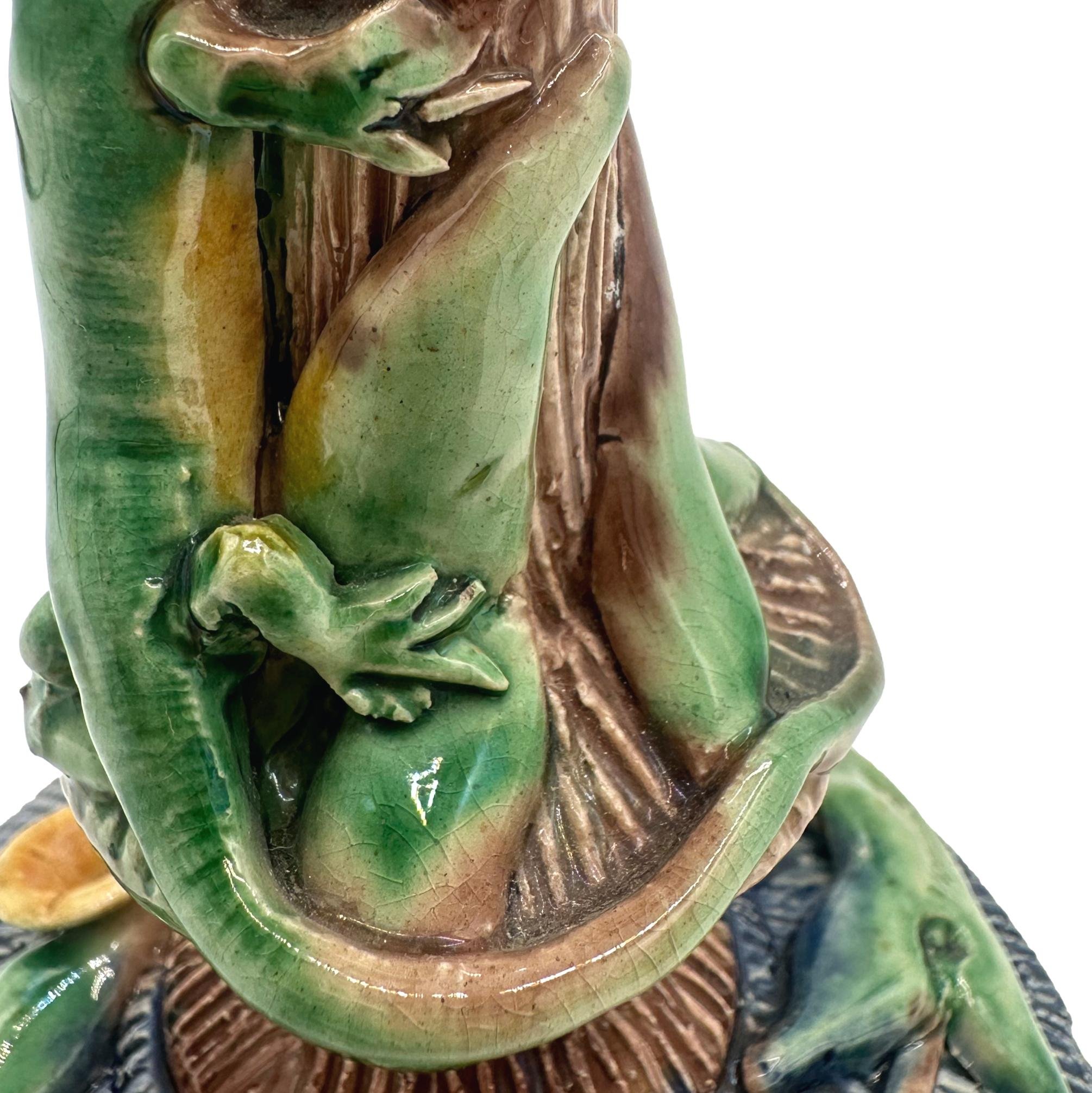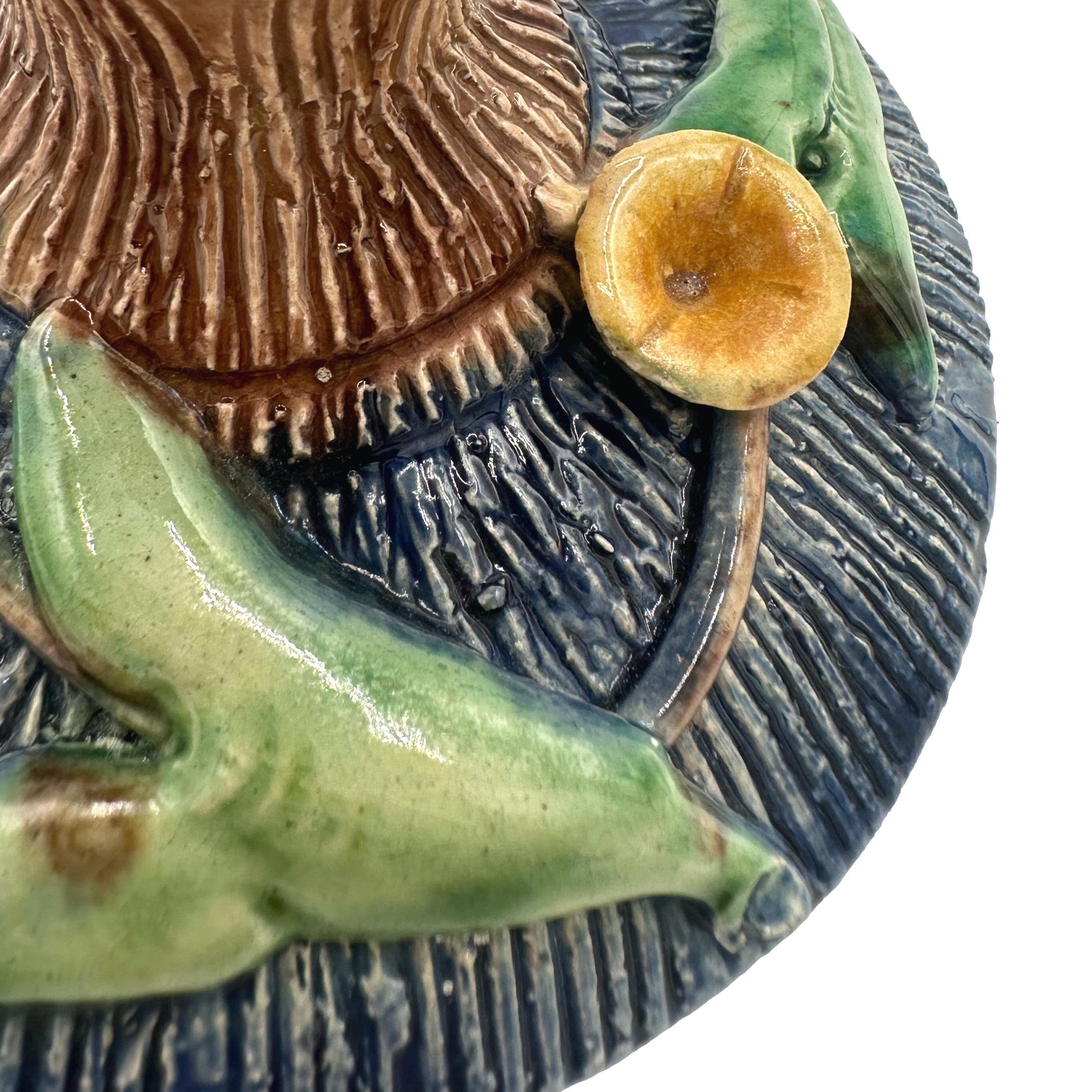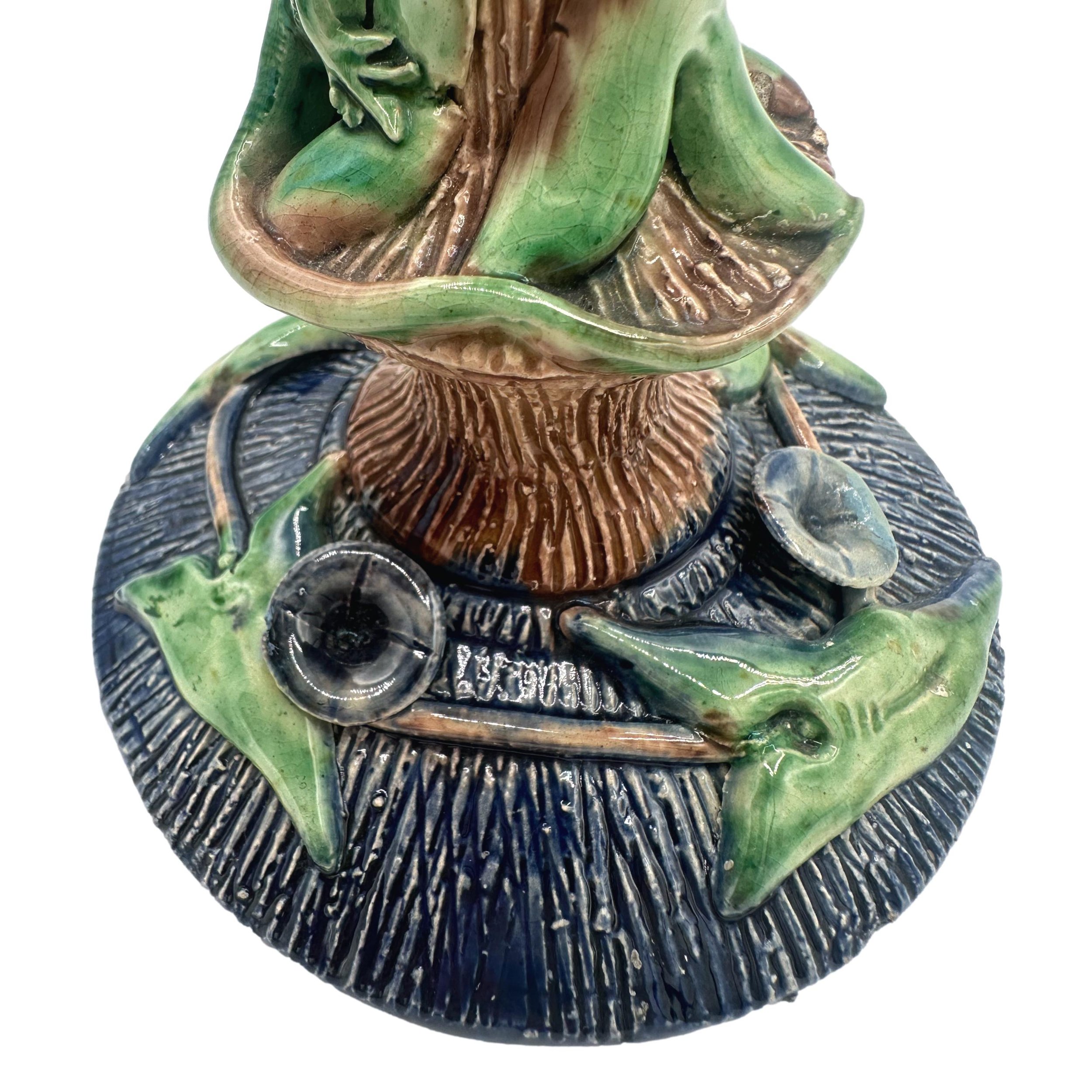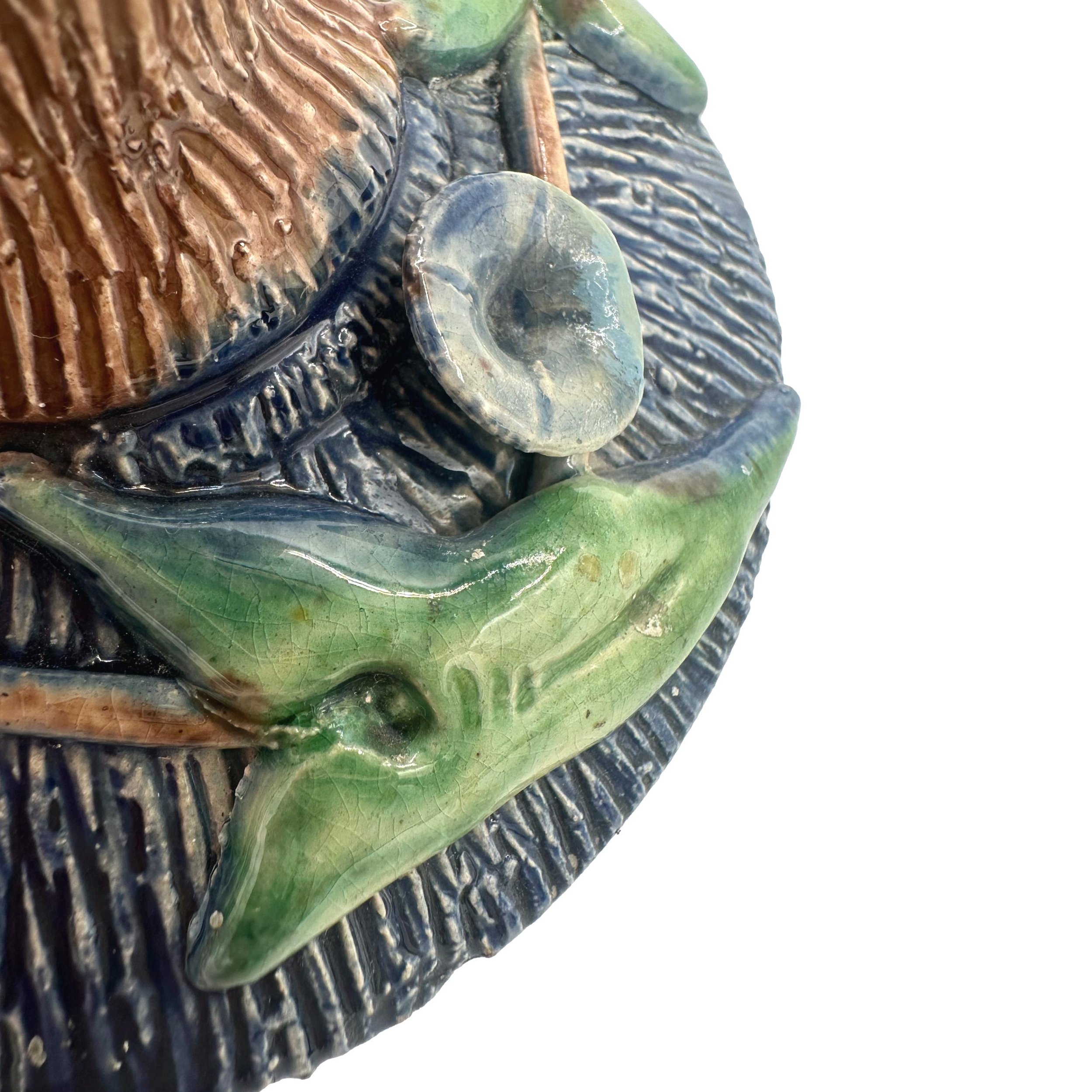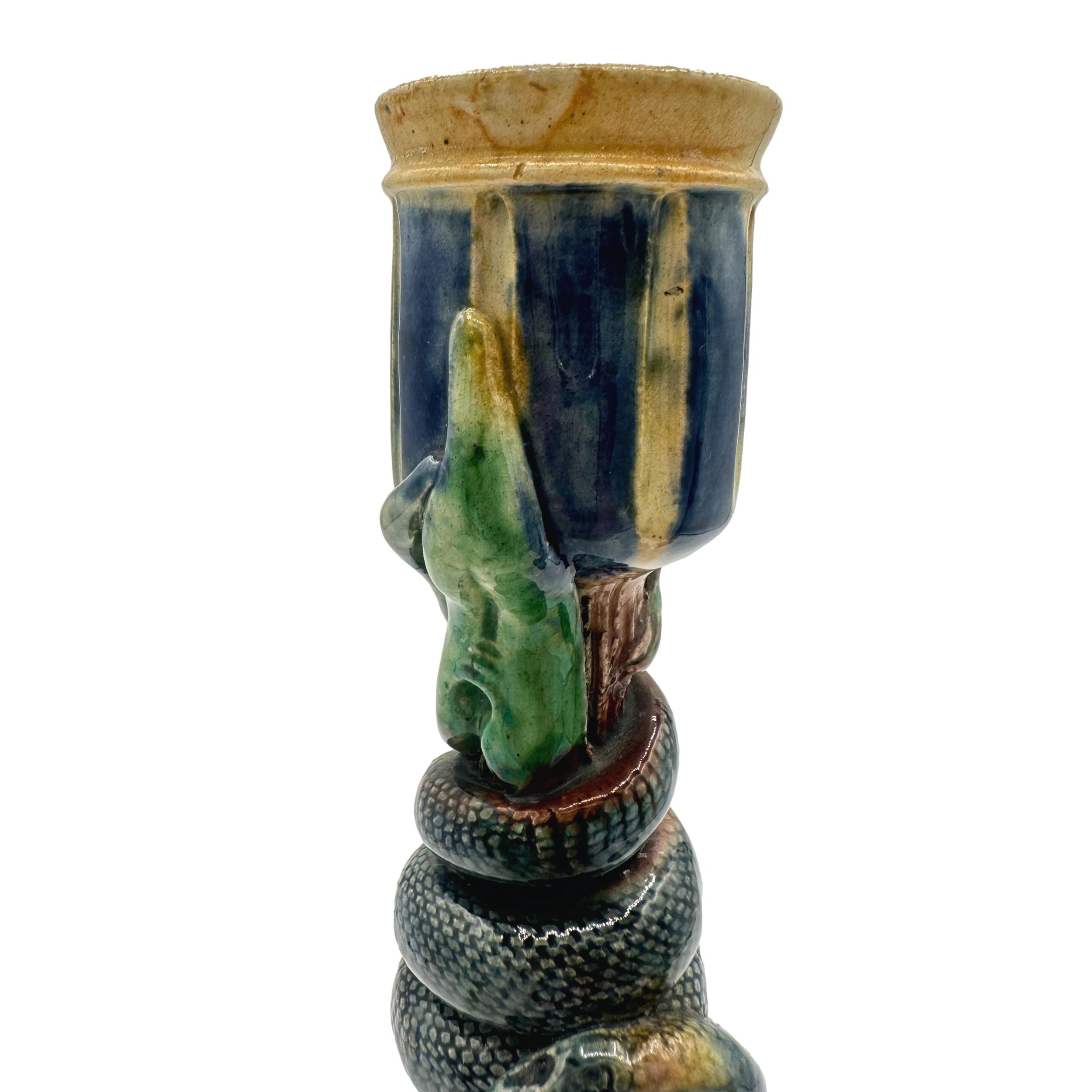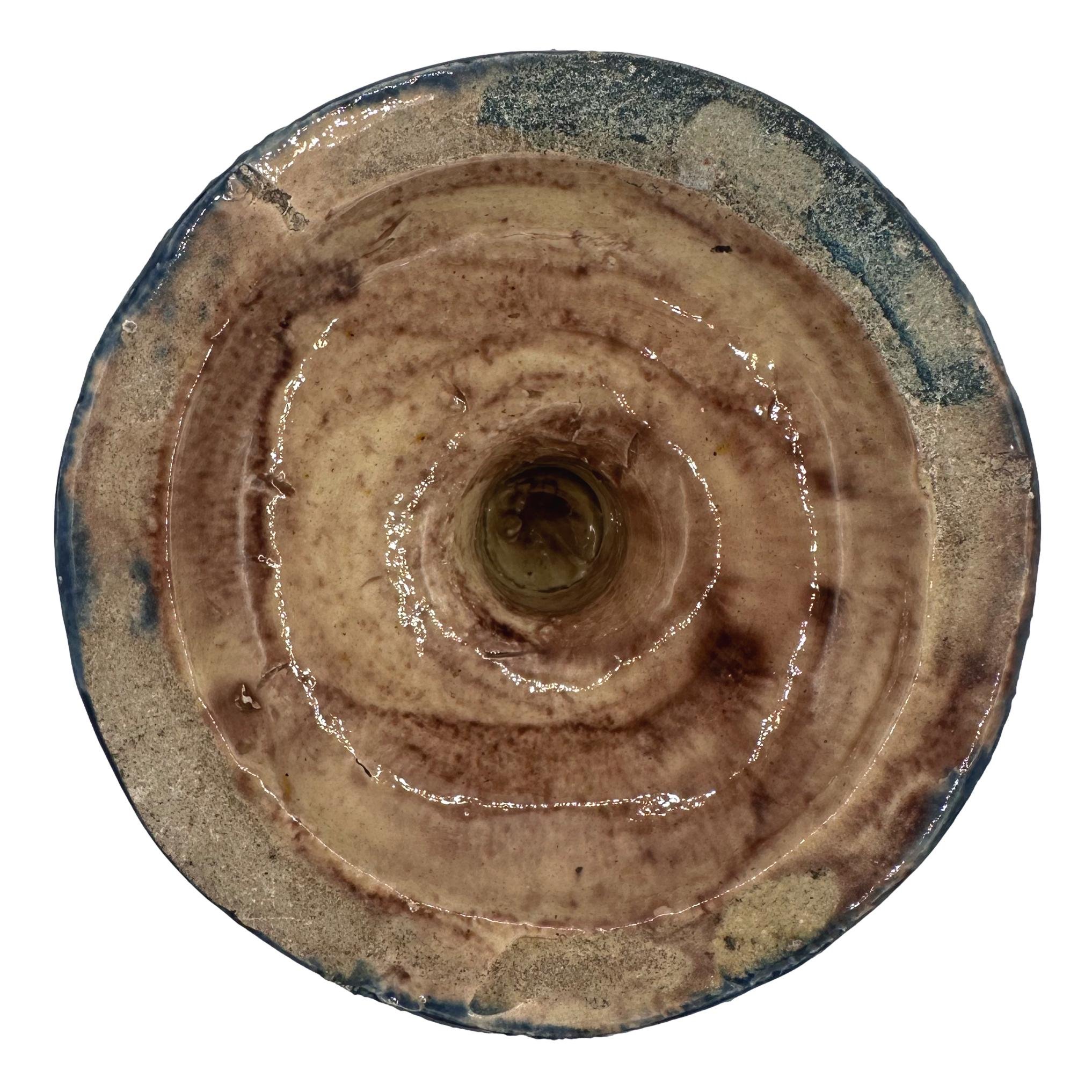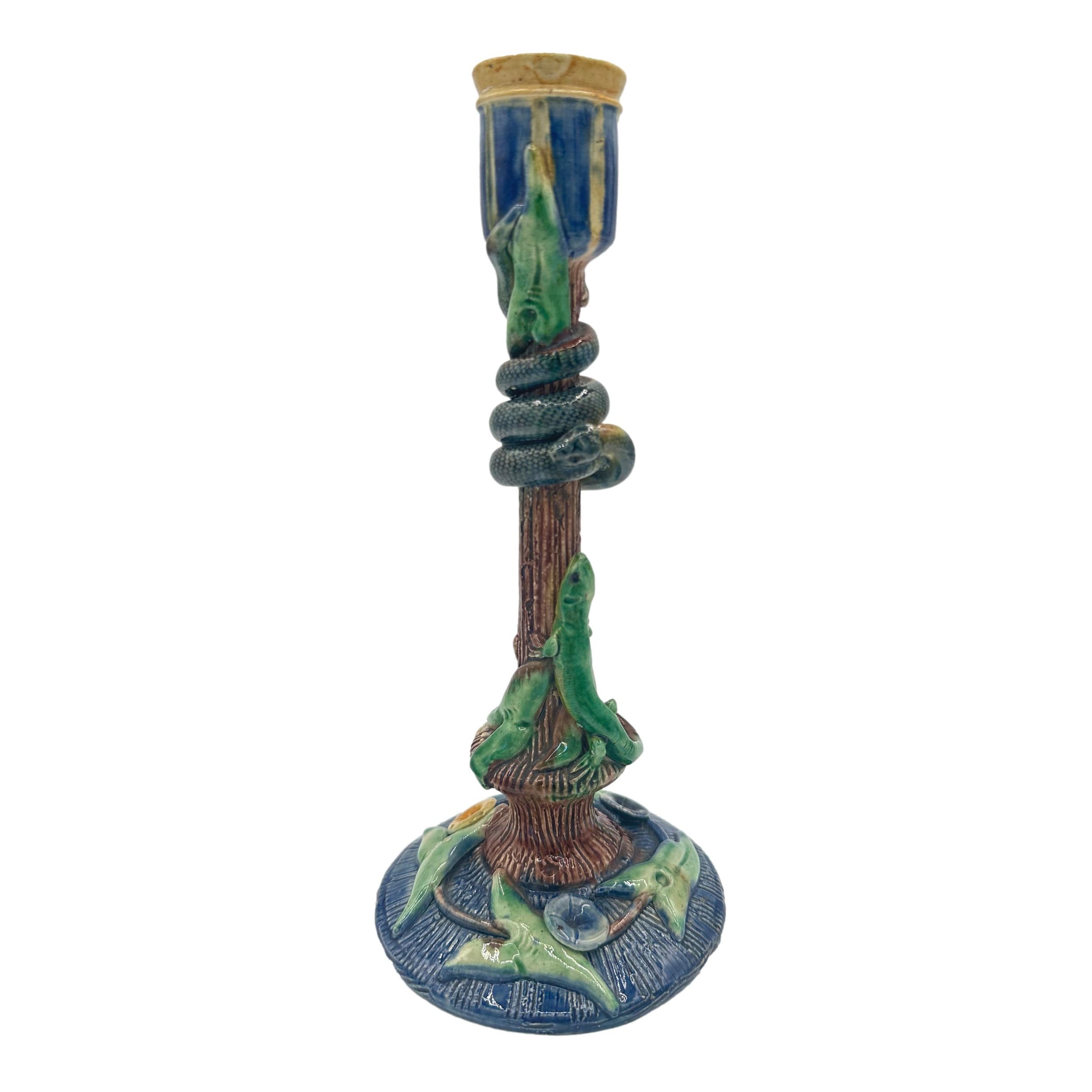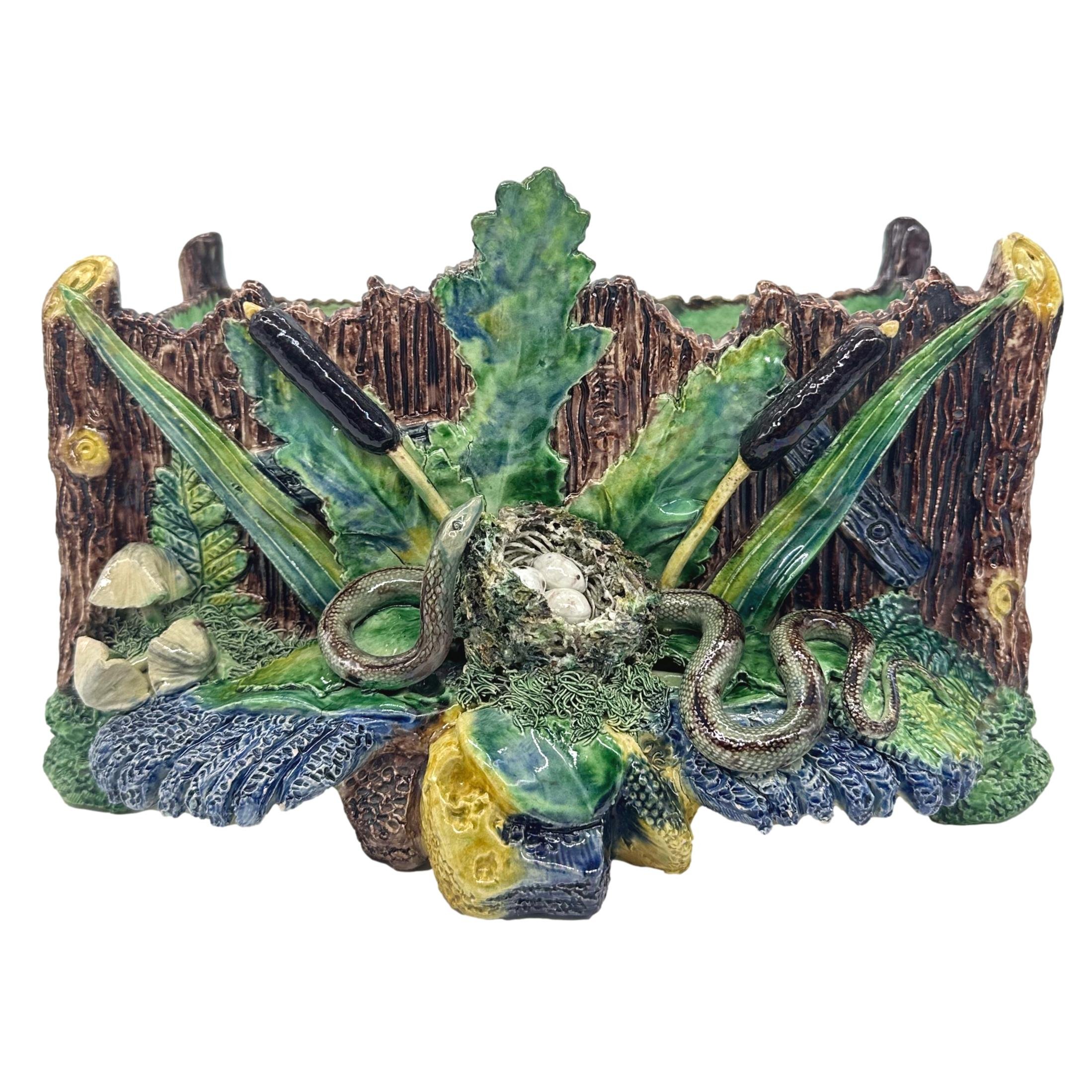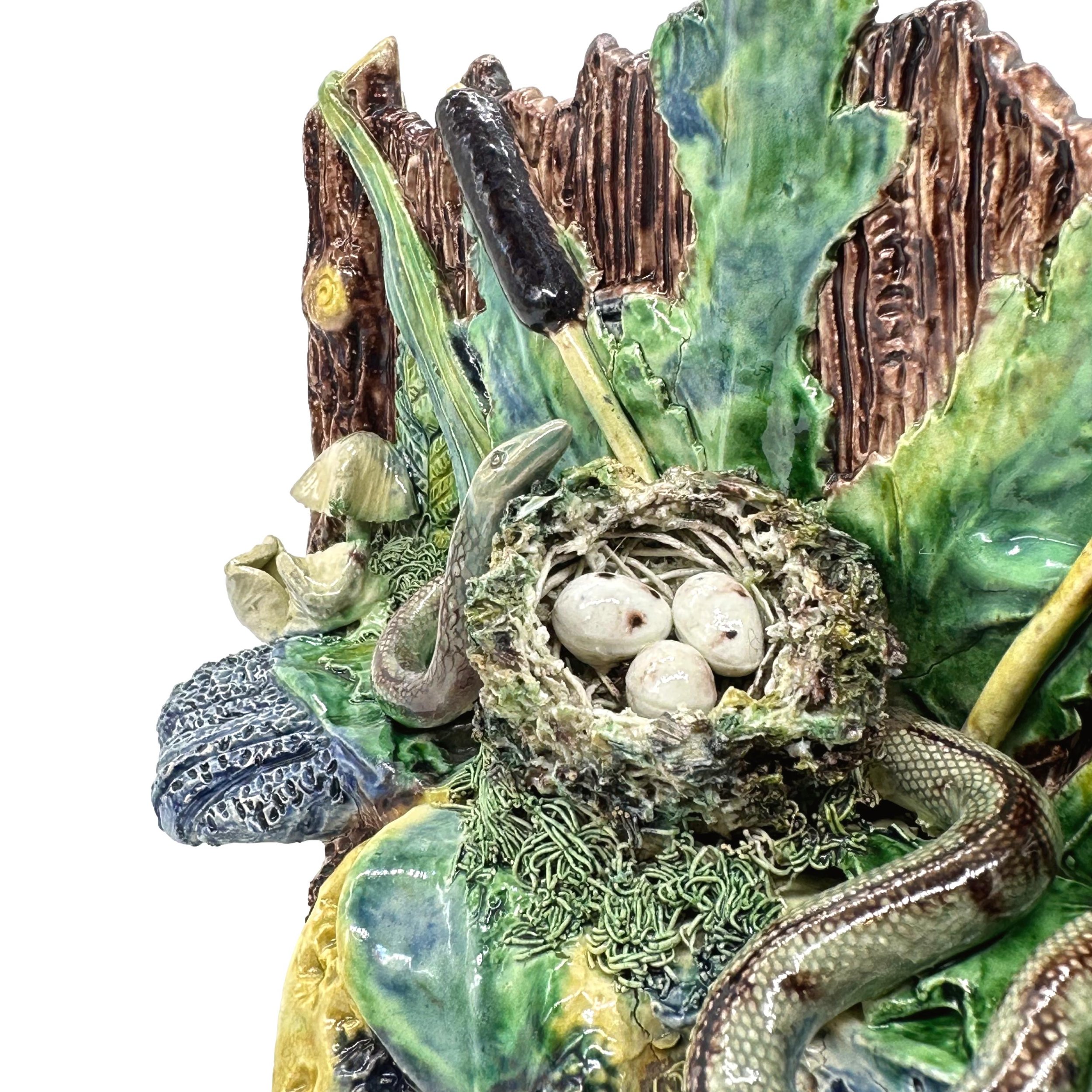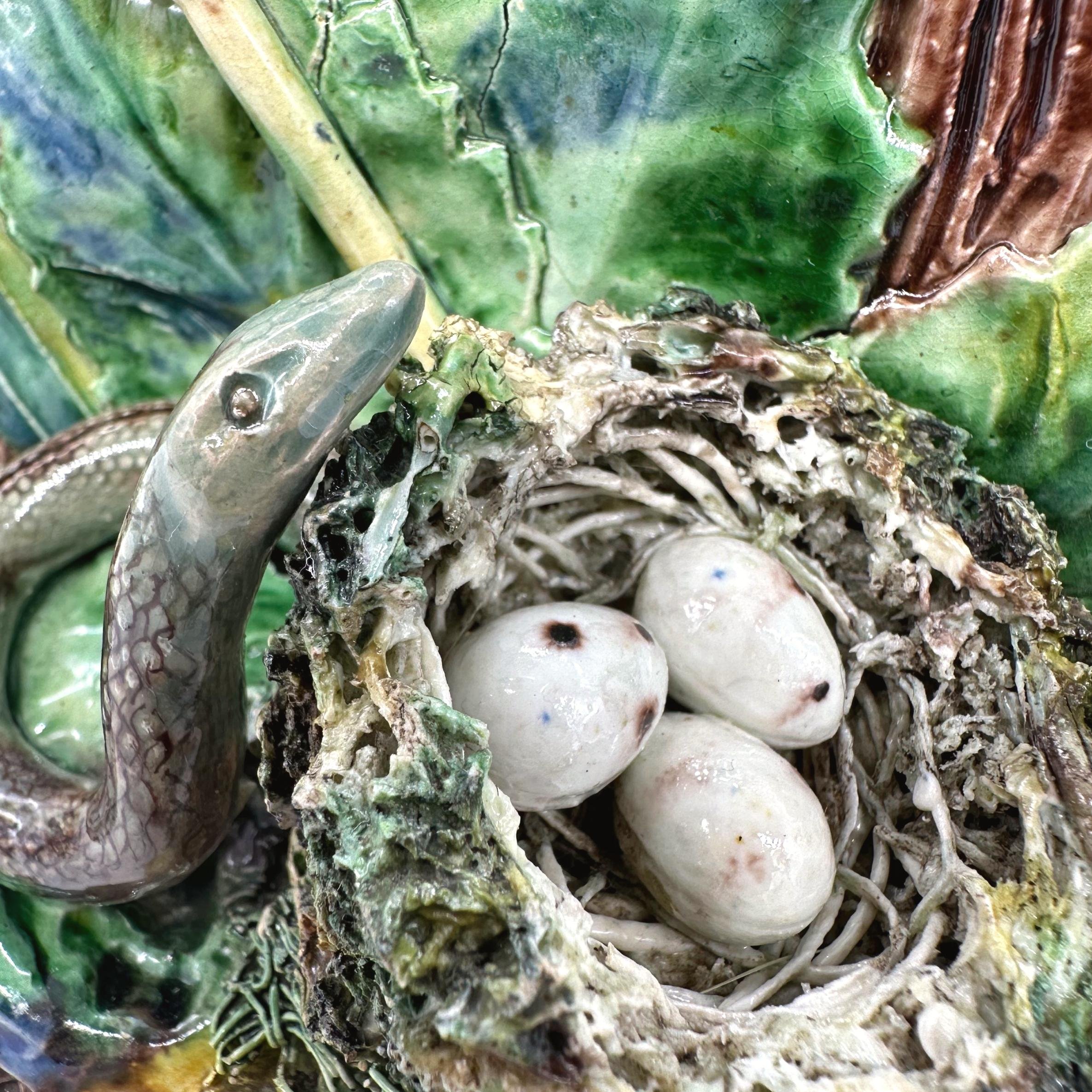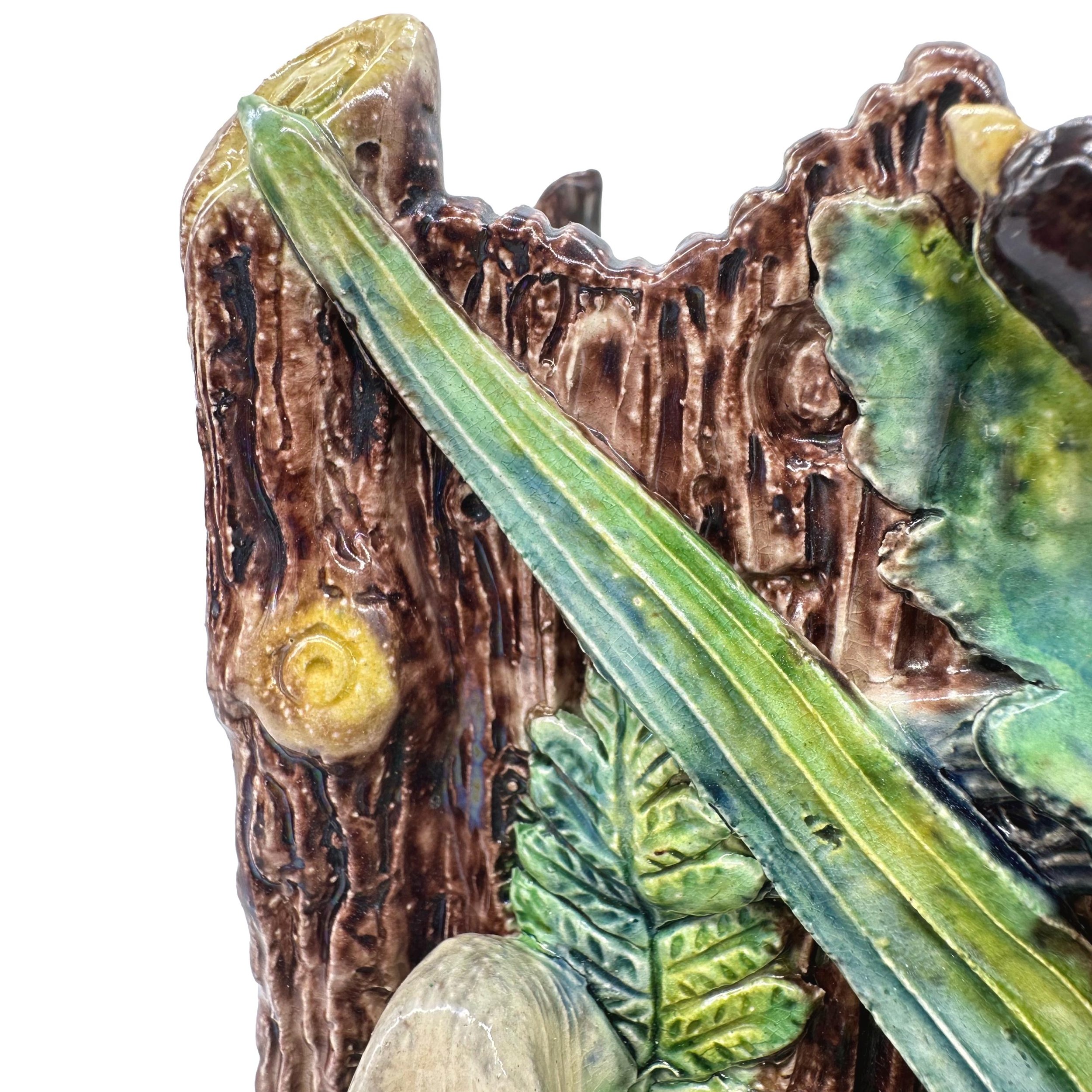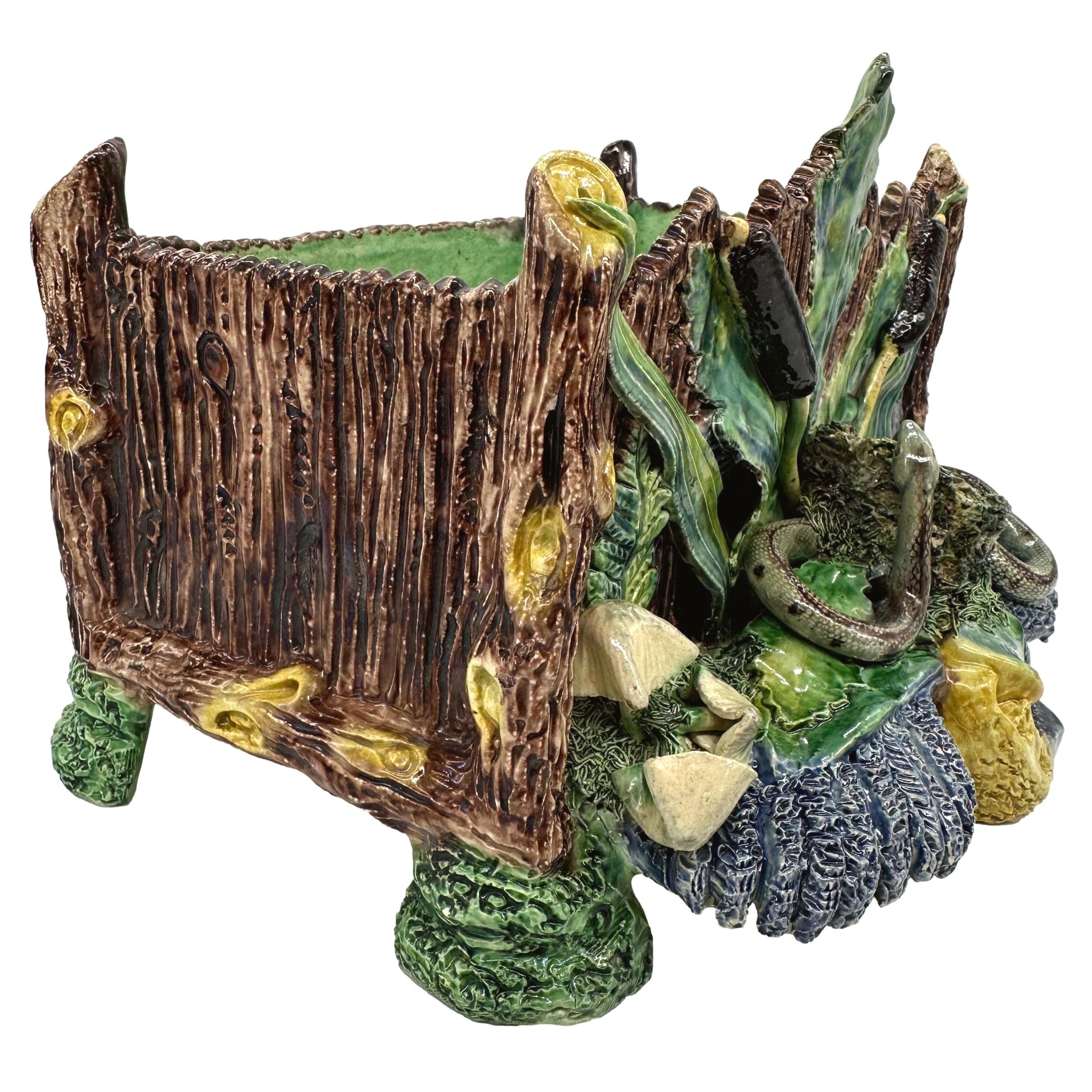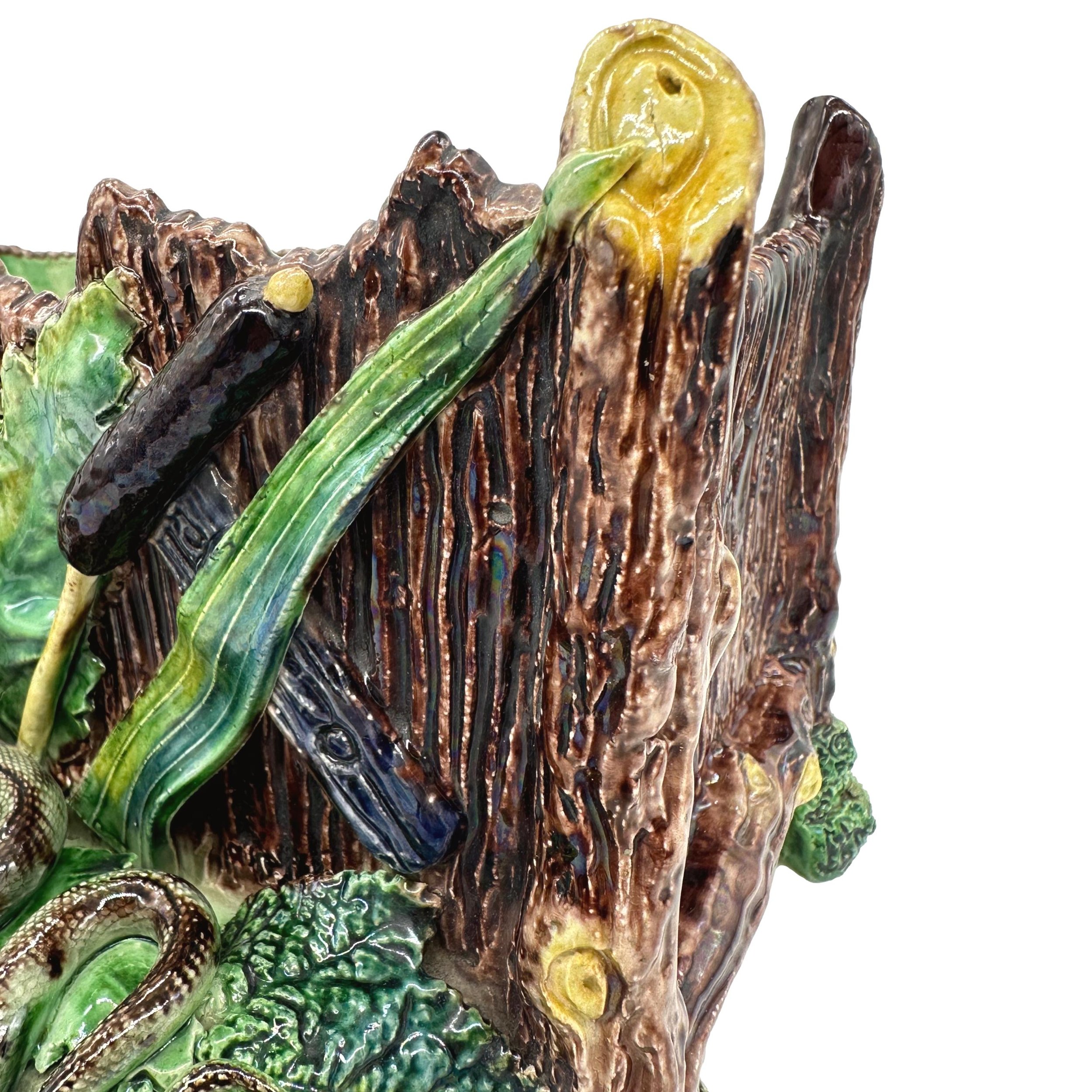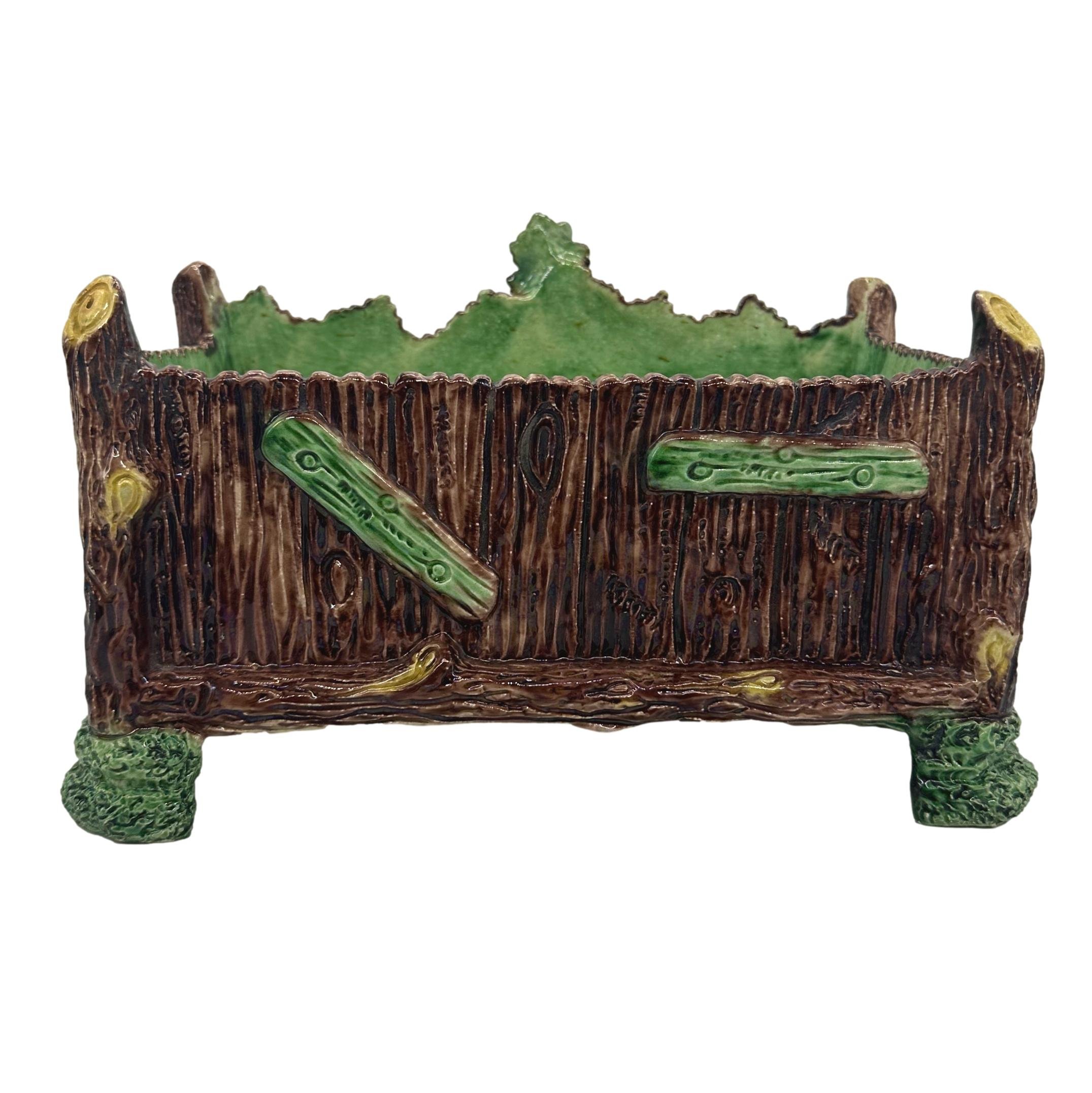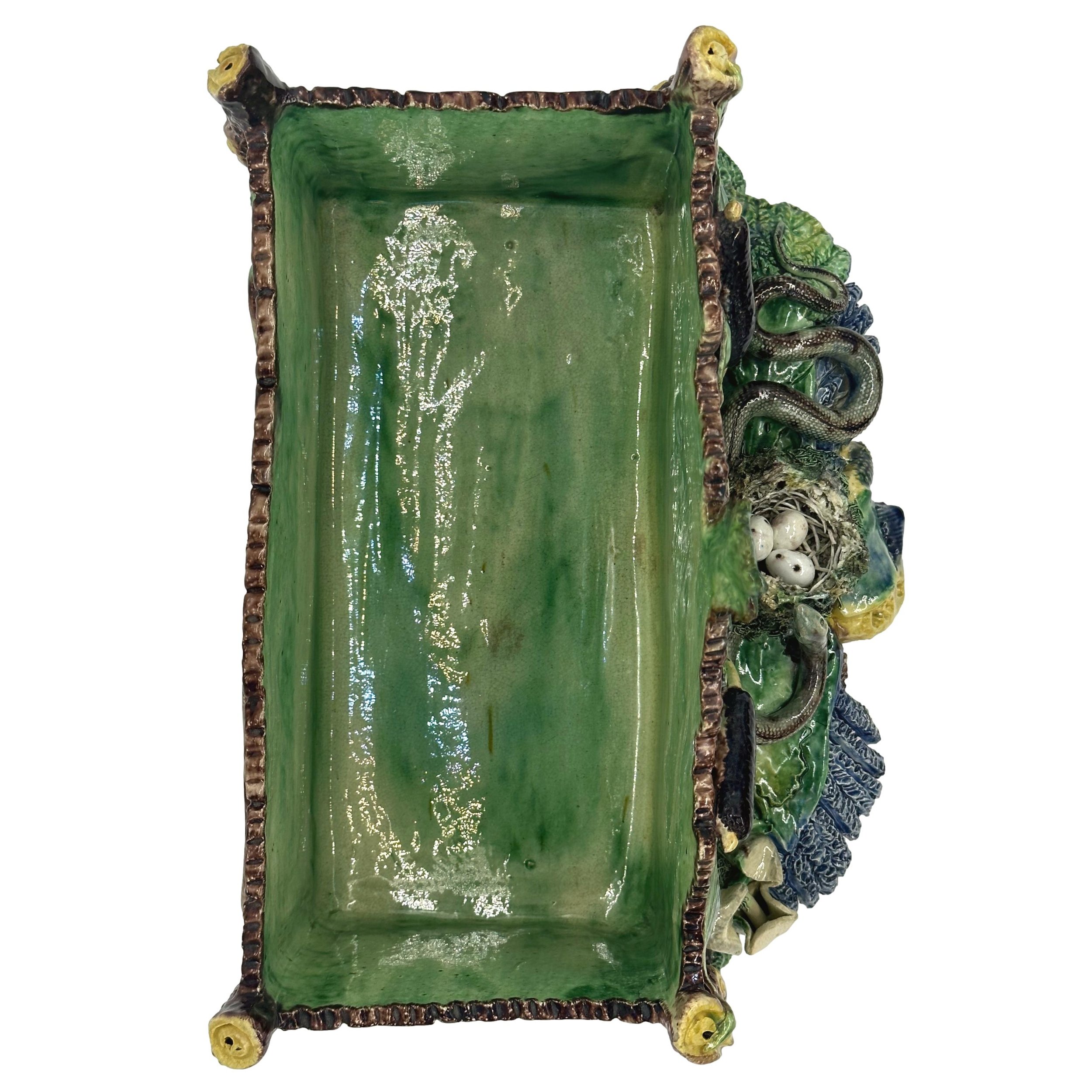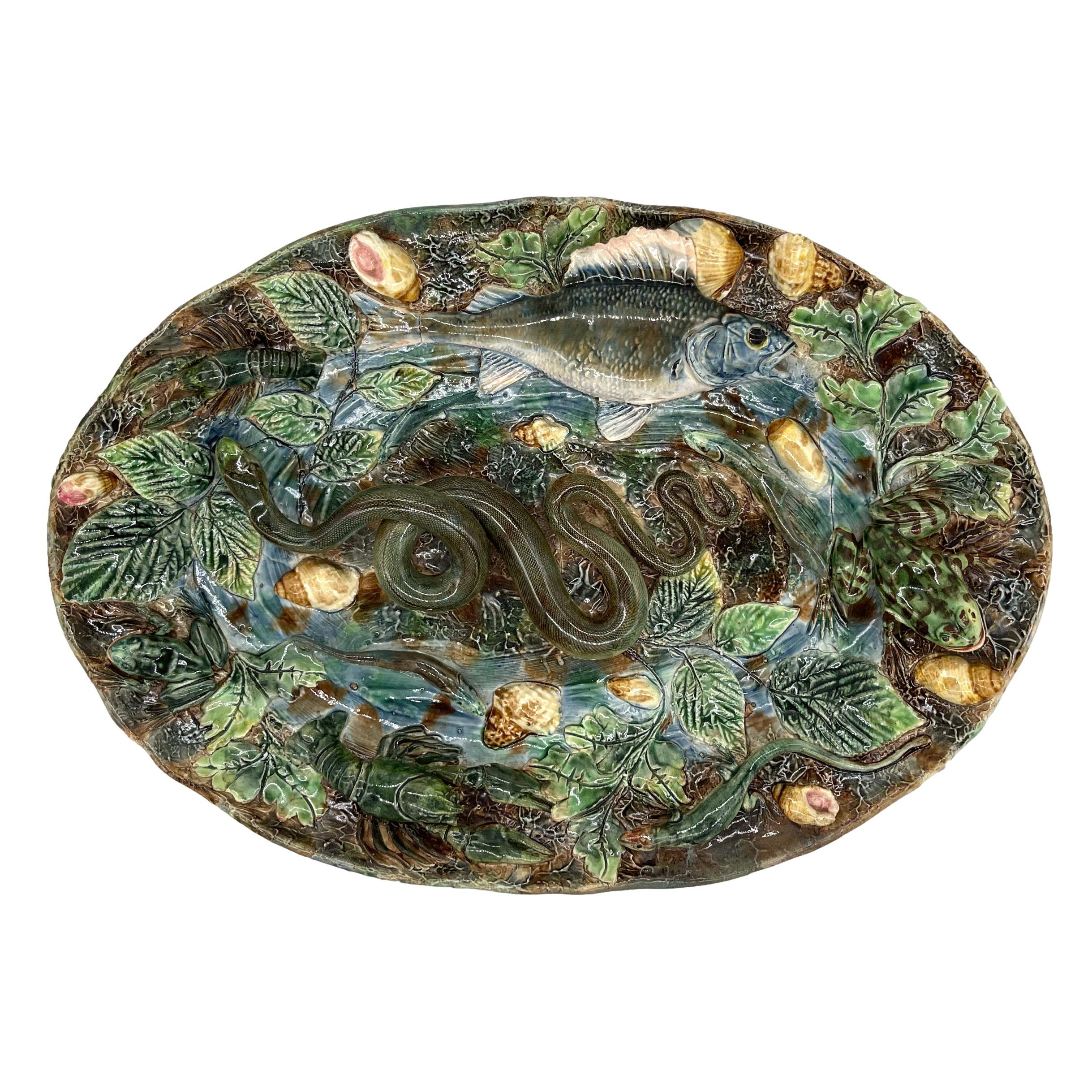 Image 1 of 19
Image 1 of 19

 Image 2 of 19
Image 2 of 19

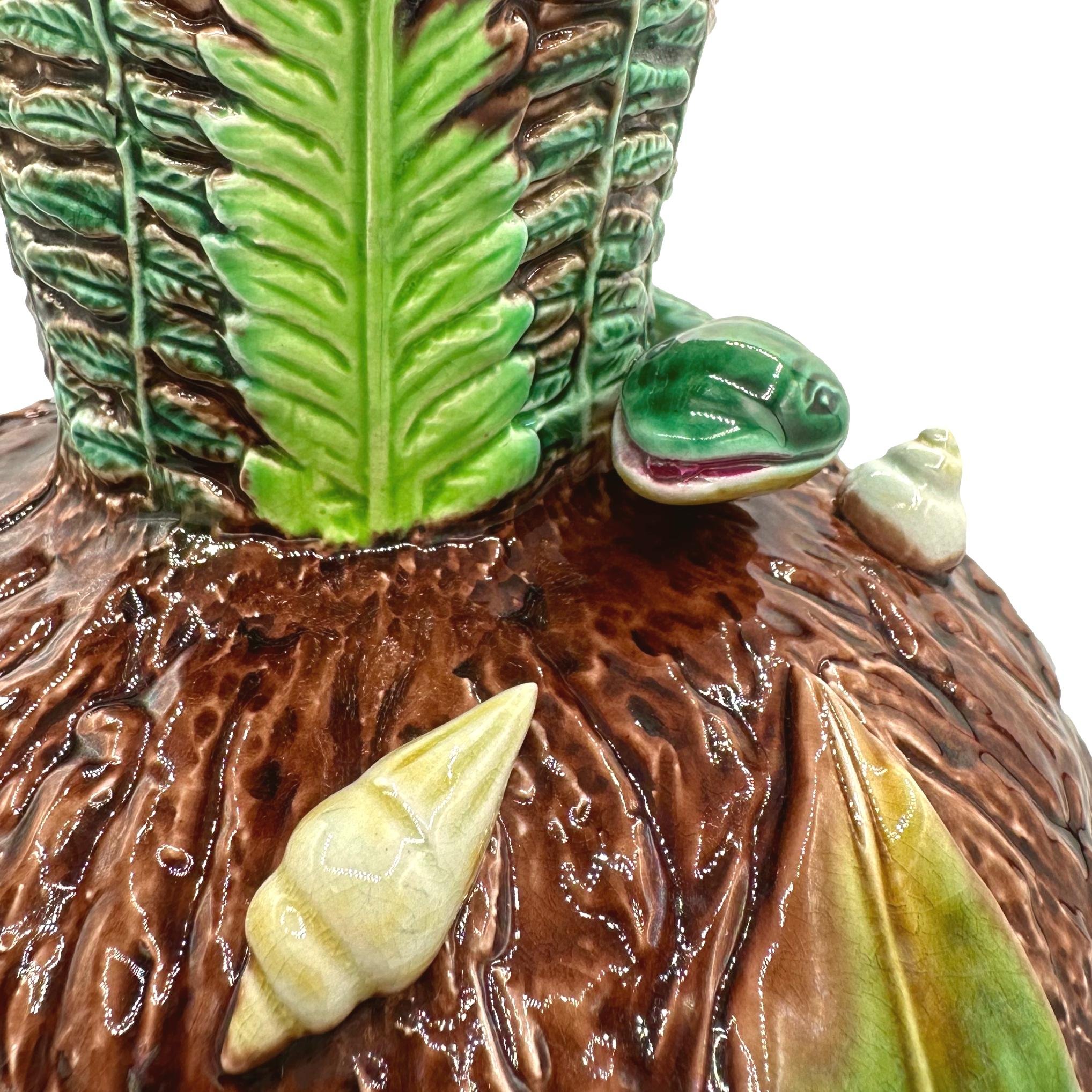 Image 3 of 19
Image 3 of 19

 Image 4 of 19
Image 4 of 19

 Image 5 of 19
Image 5 of 19

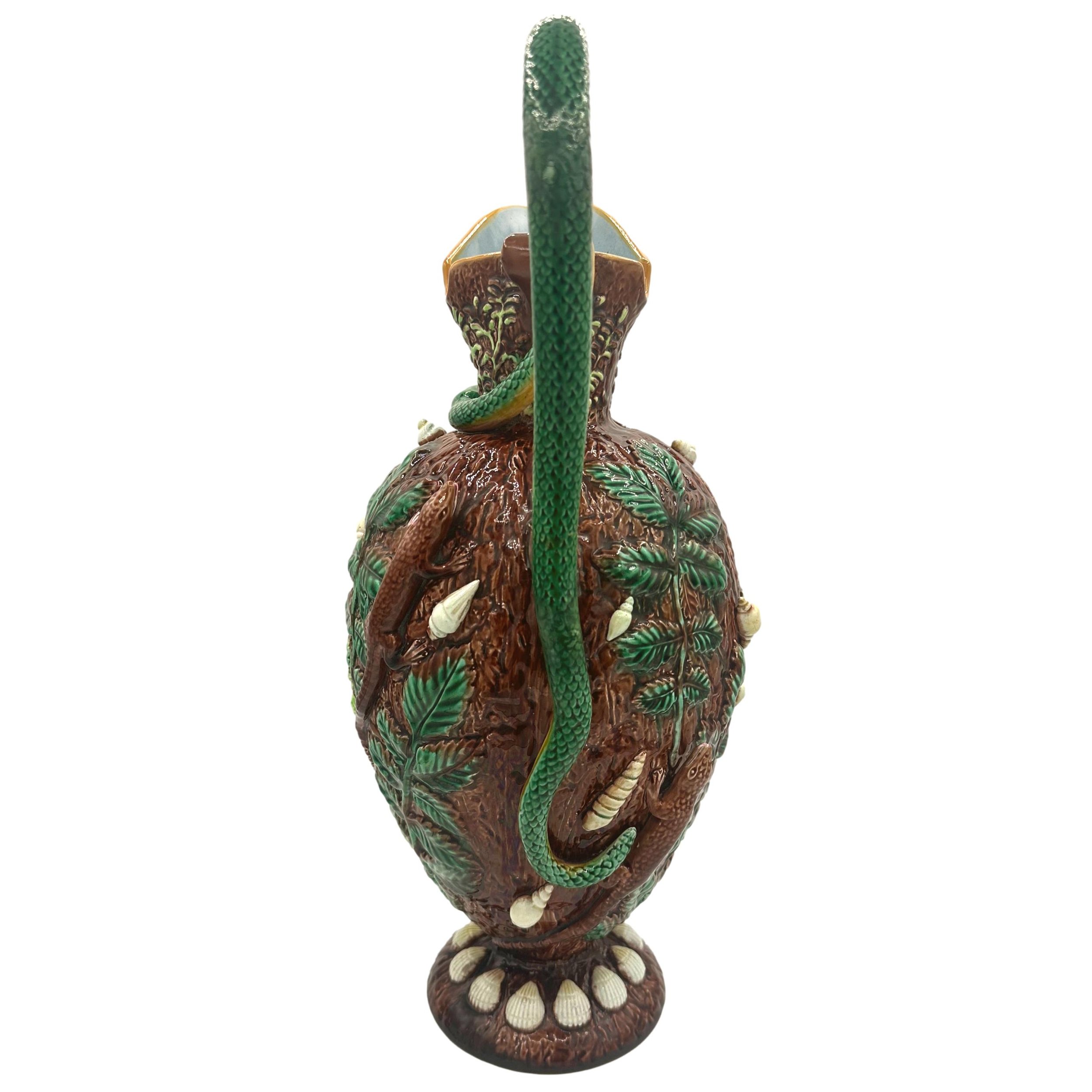 Image 6 of 19
Image 6 of 19

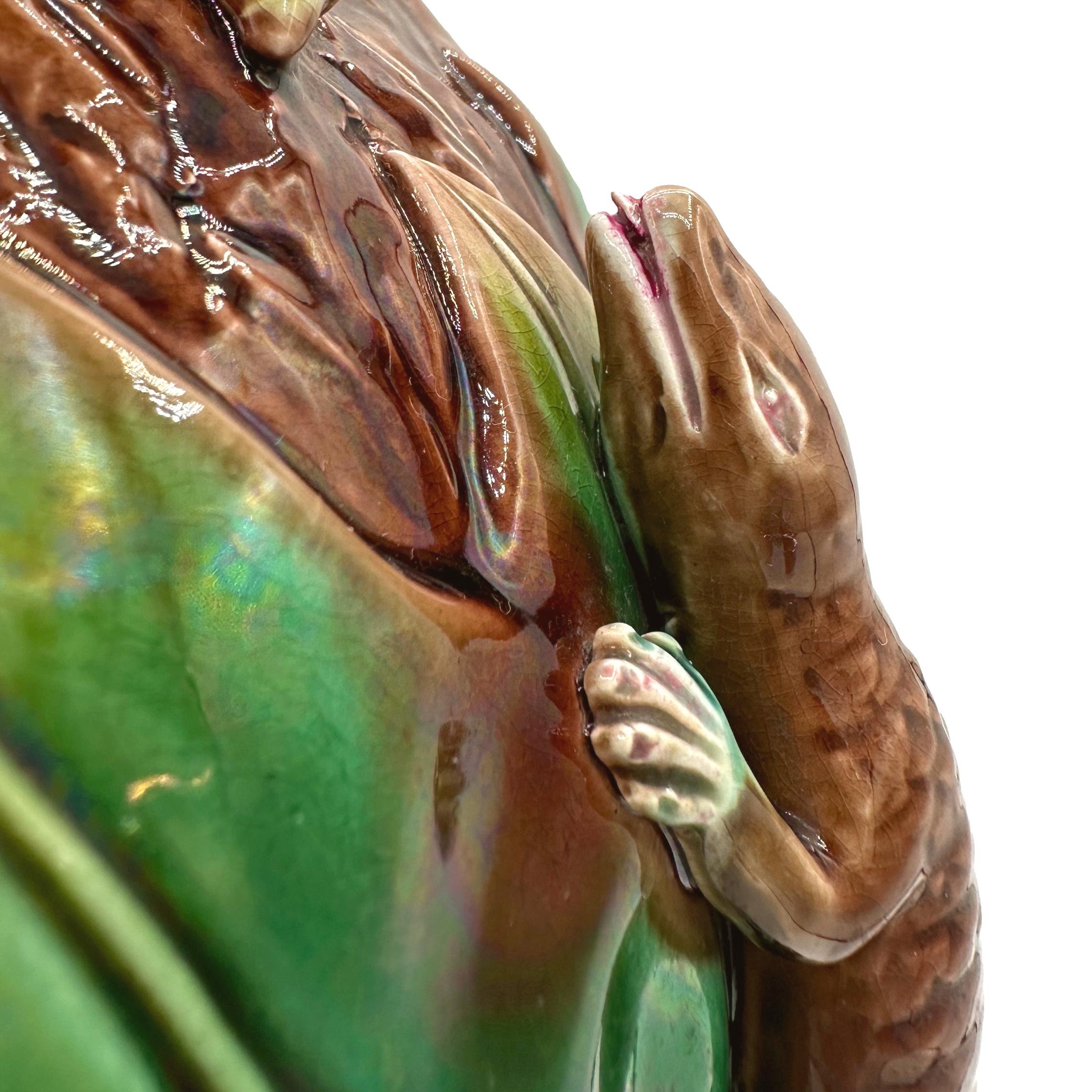 Image 7 of 19
Image 7 of 19

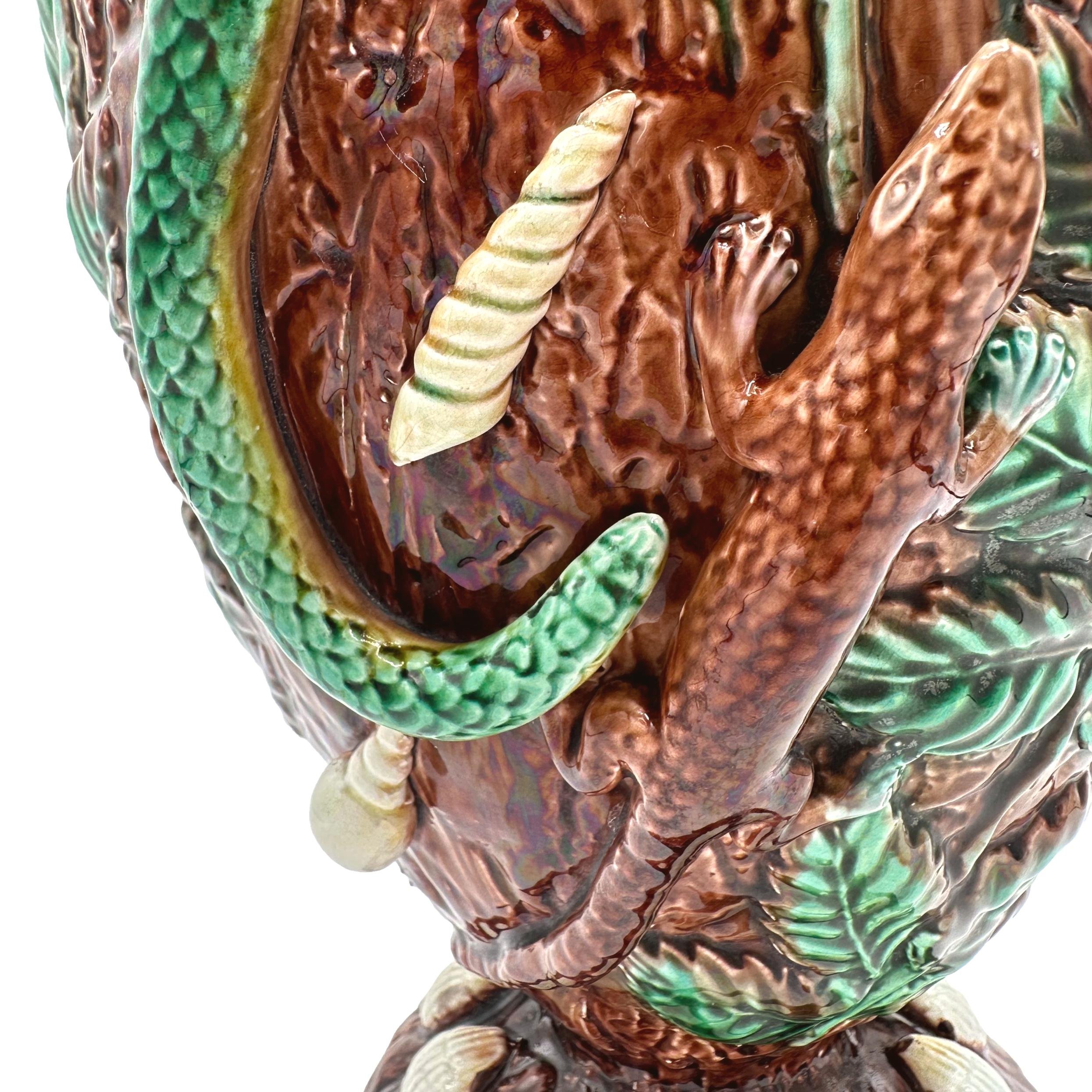 Image 8 of 19
Image 8 of 19

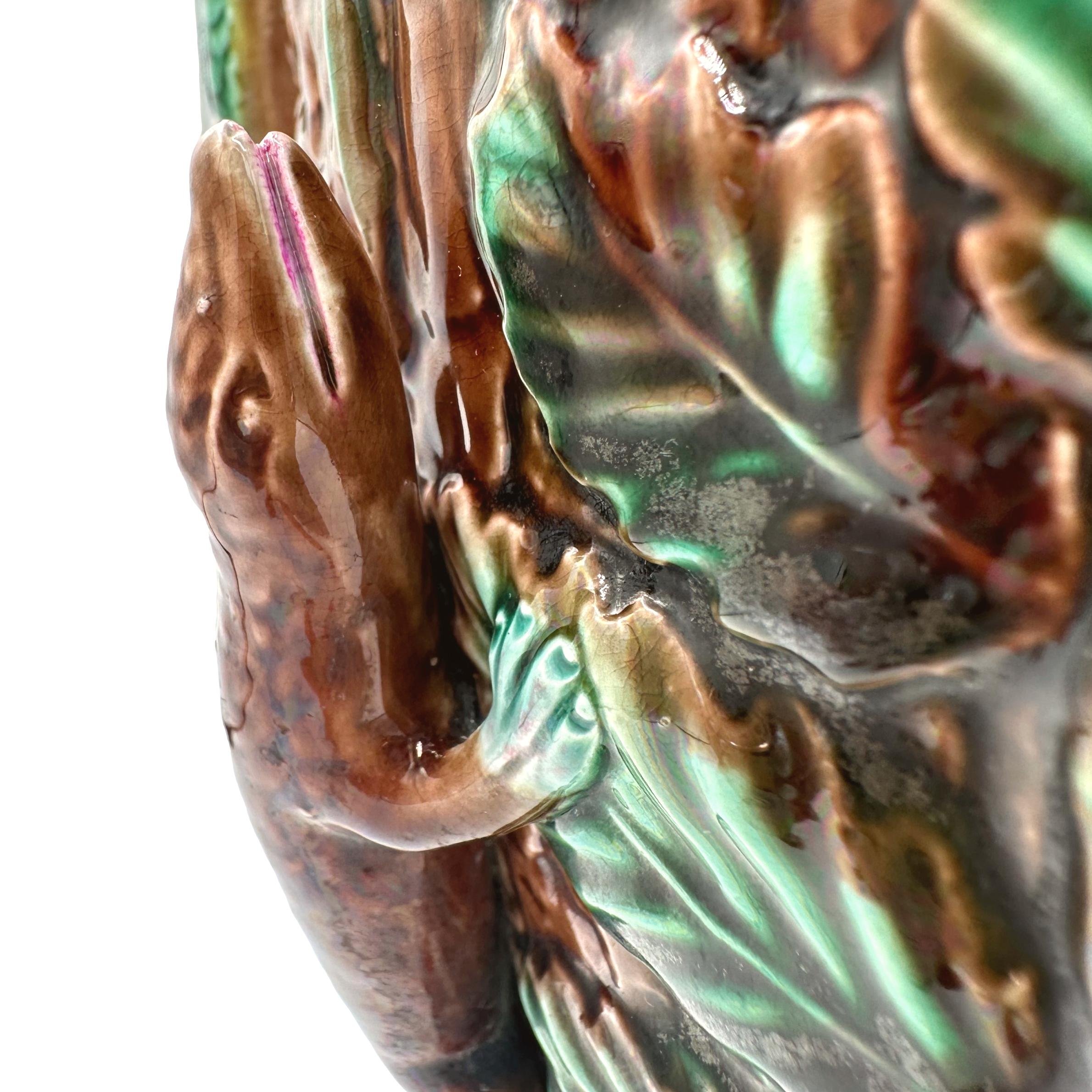 Image 9 of 19
Image 9 of 19

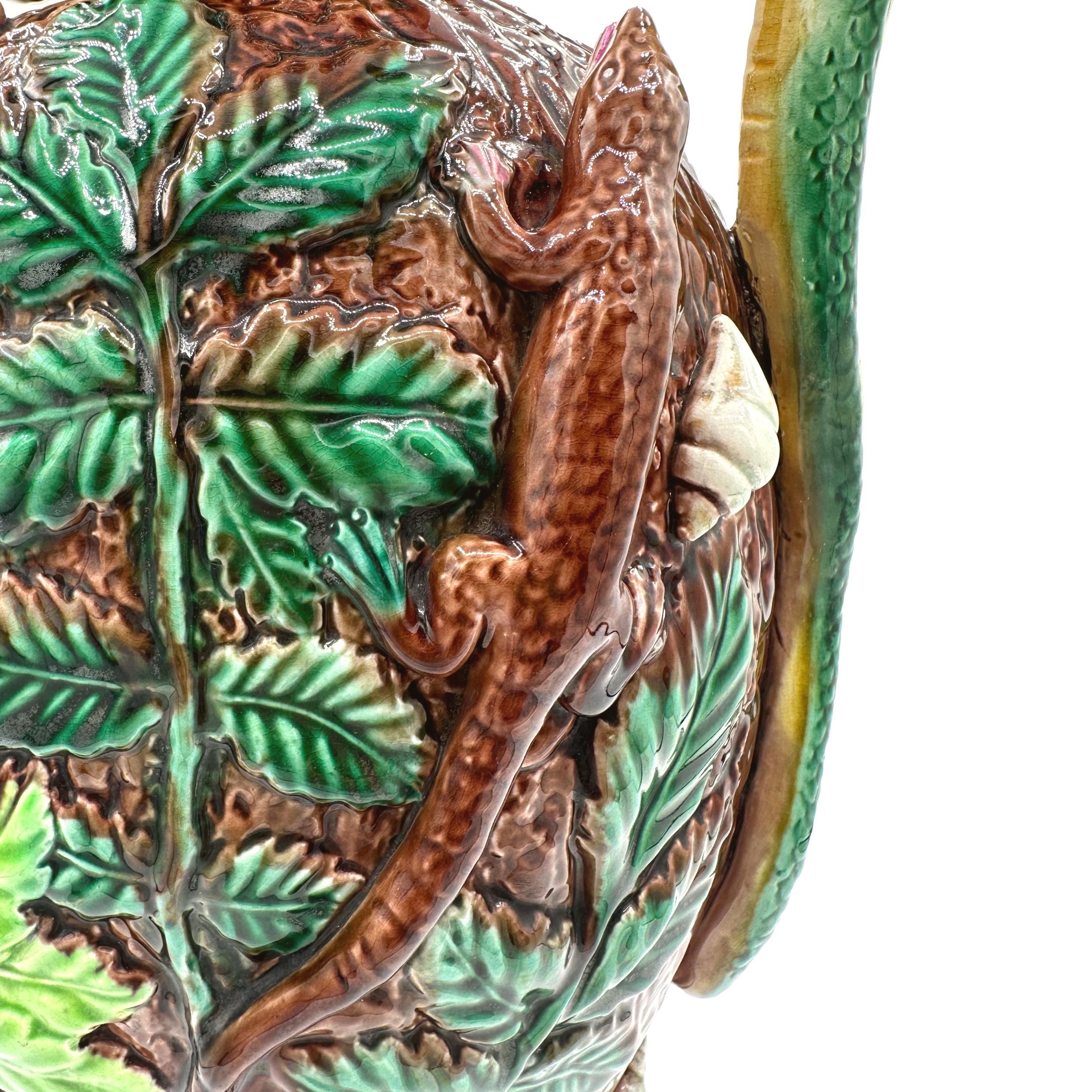 Image 10 of 19
Image 10 of 19

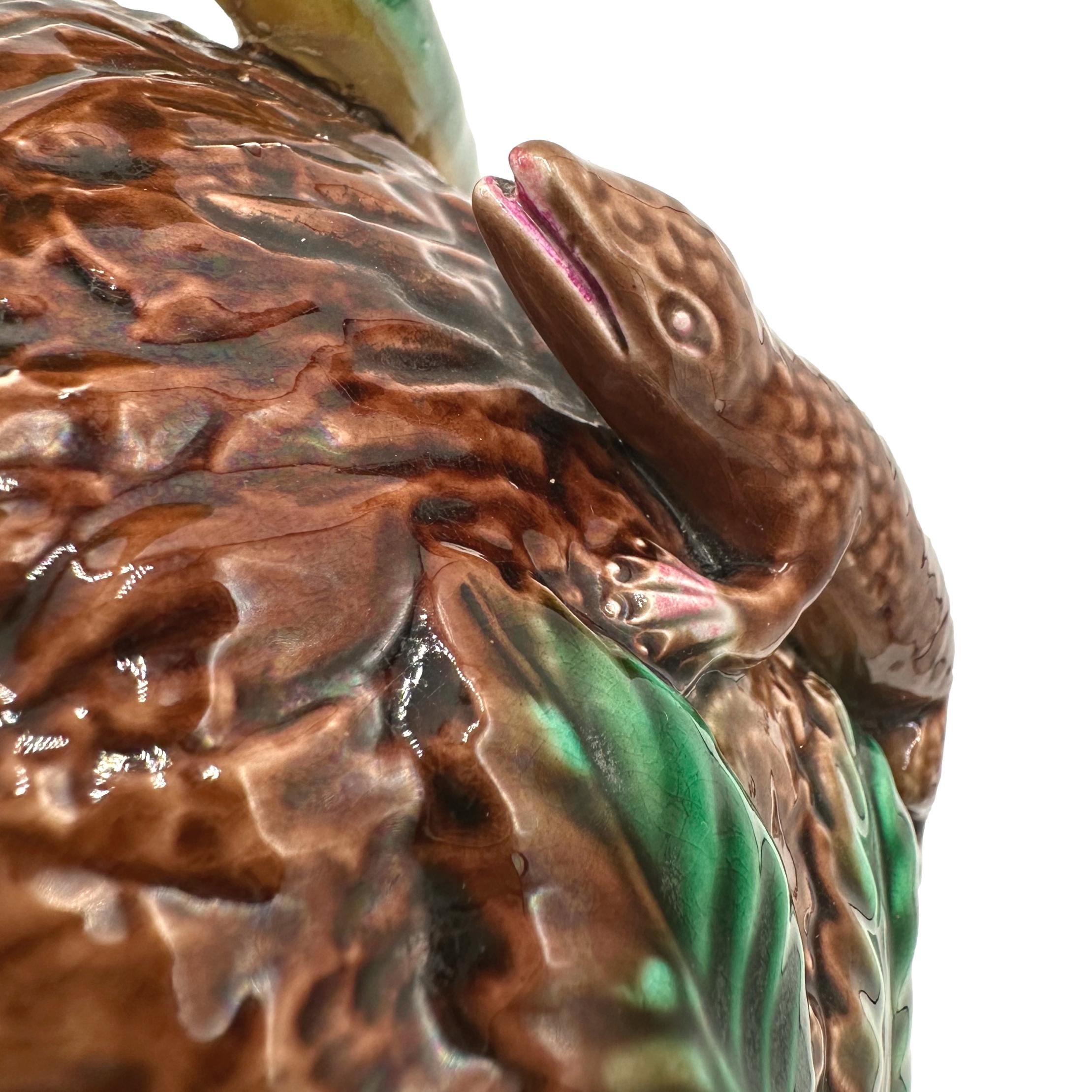 Image 11 of 19
Image 11 of 19

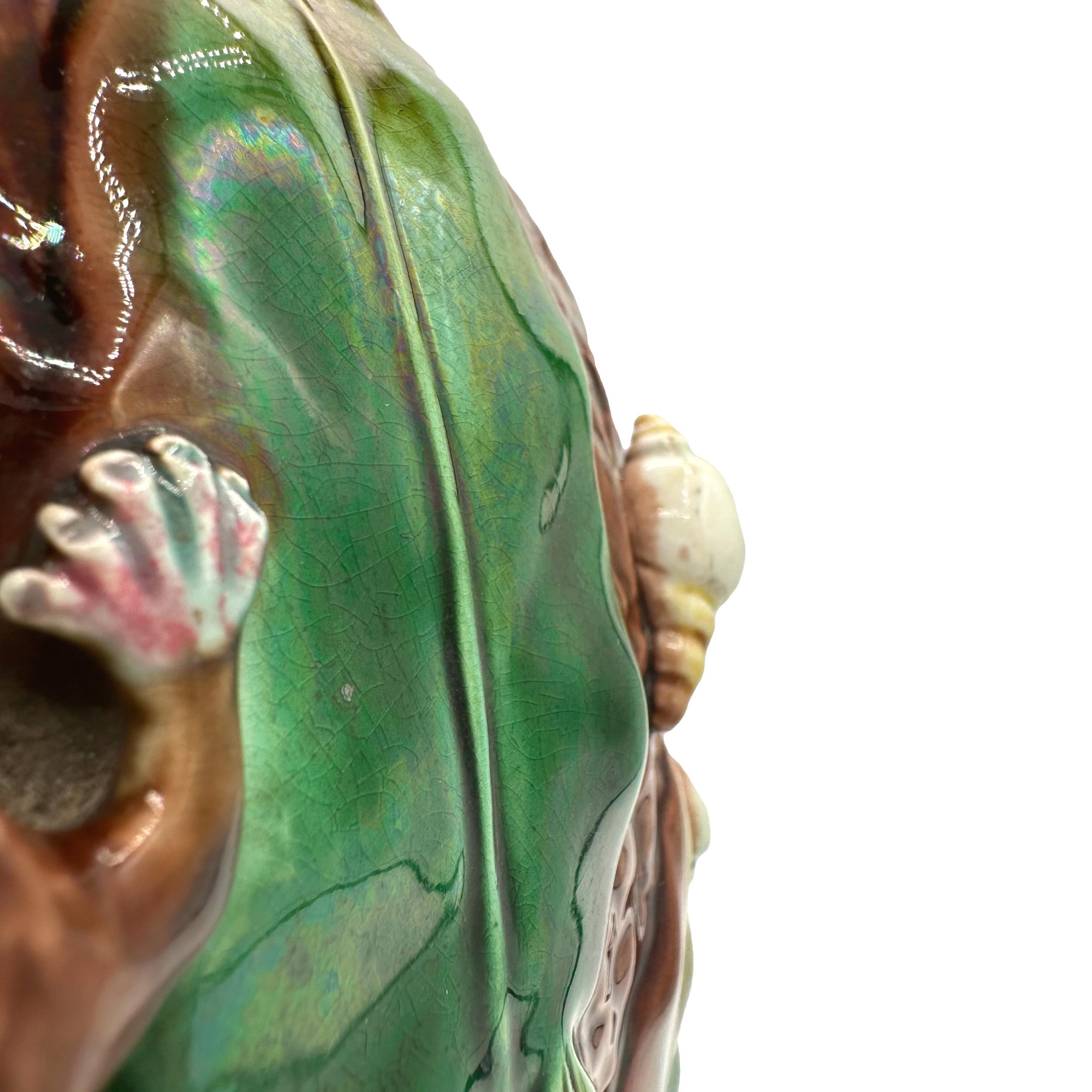 Image 12 of 19
Image 12 of 19

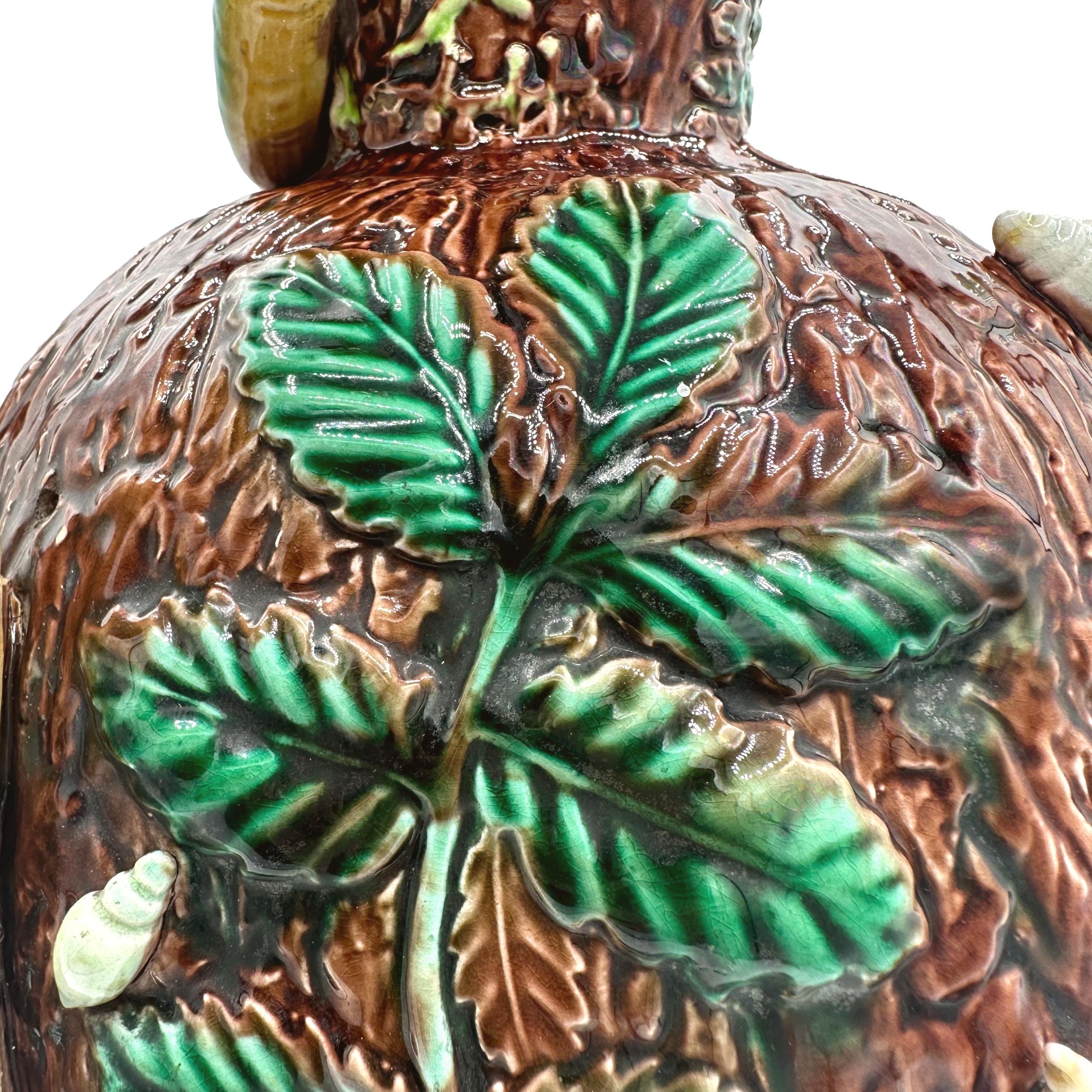 Image 13 of 19
Image 13 of 19

 Image 14 of 19
Image 14 of 19

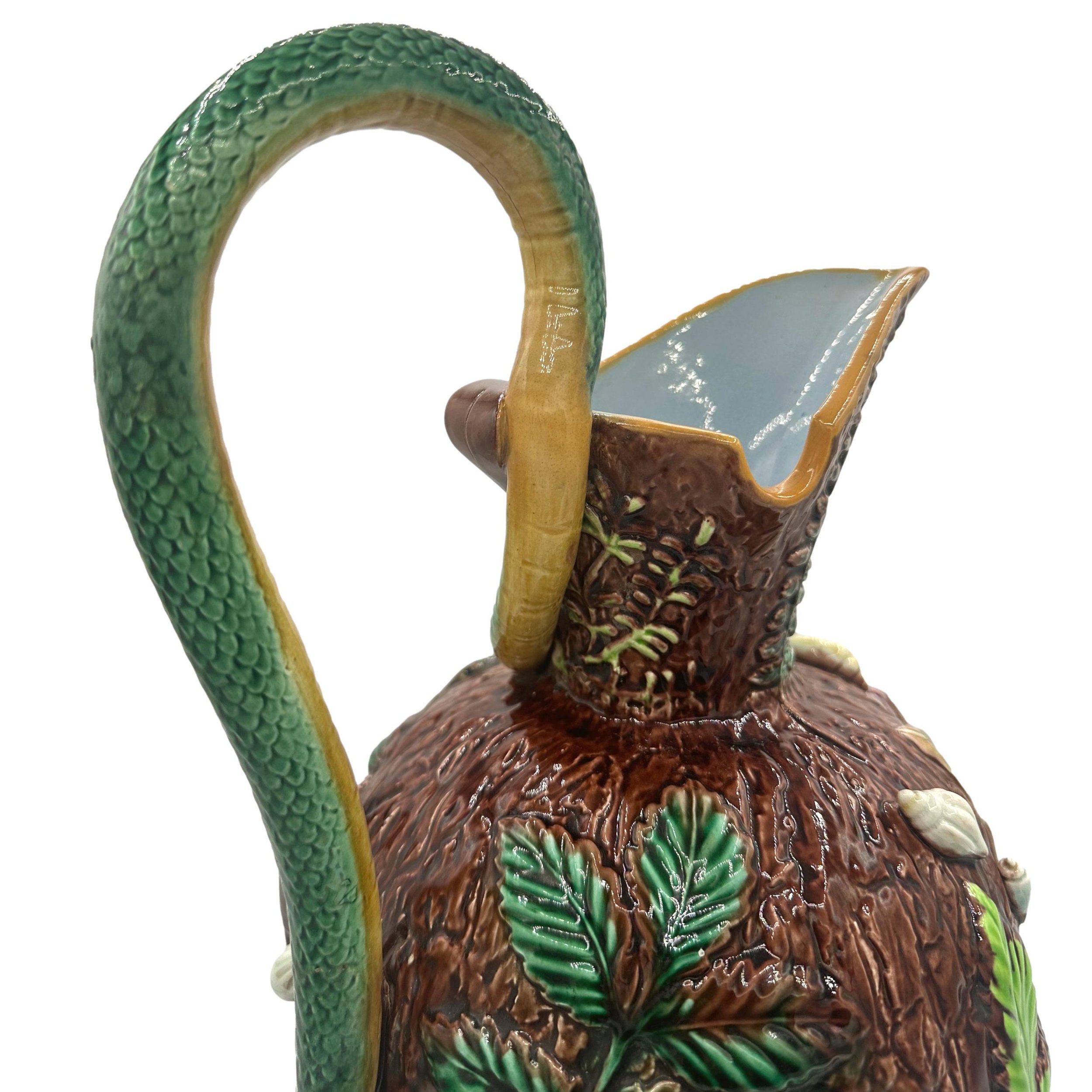 Image 15 of 19
Image 15 of 19

 Image 16 of 19
Image 16 of 19

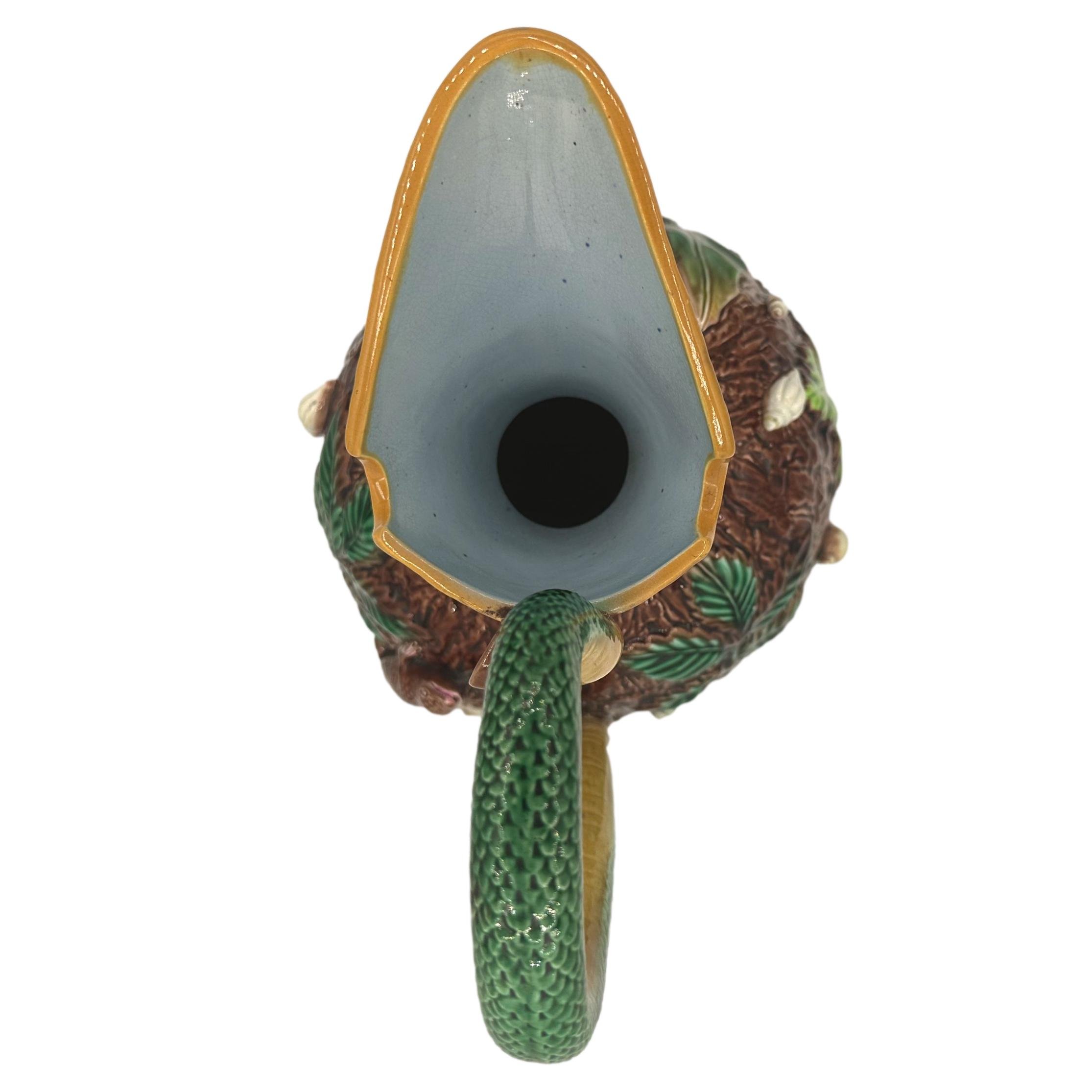 Image 17 of 19
Image 17 of 19

 Image 18 of 19
Image 18 of 19

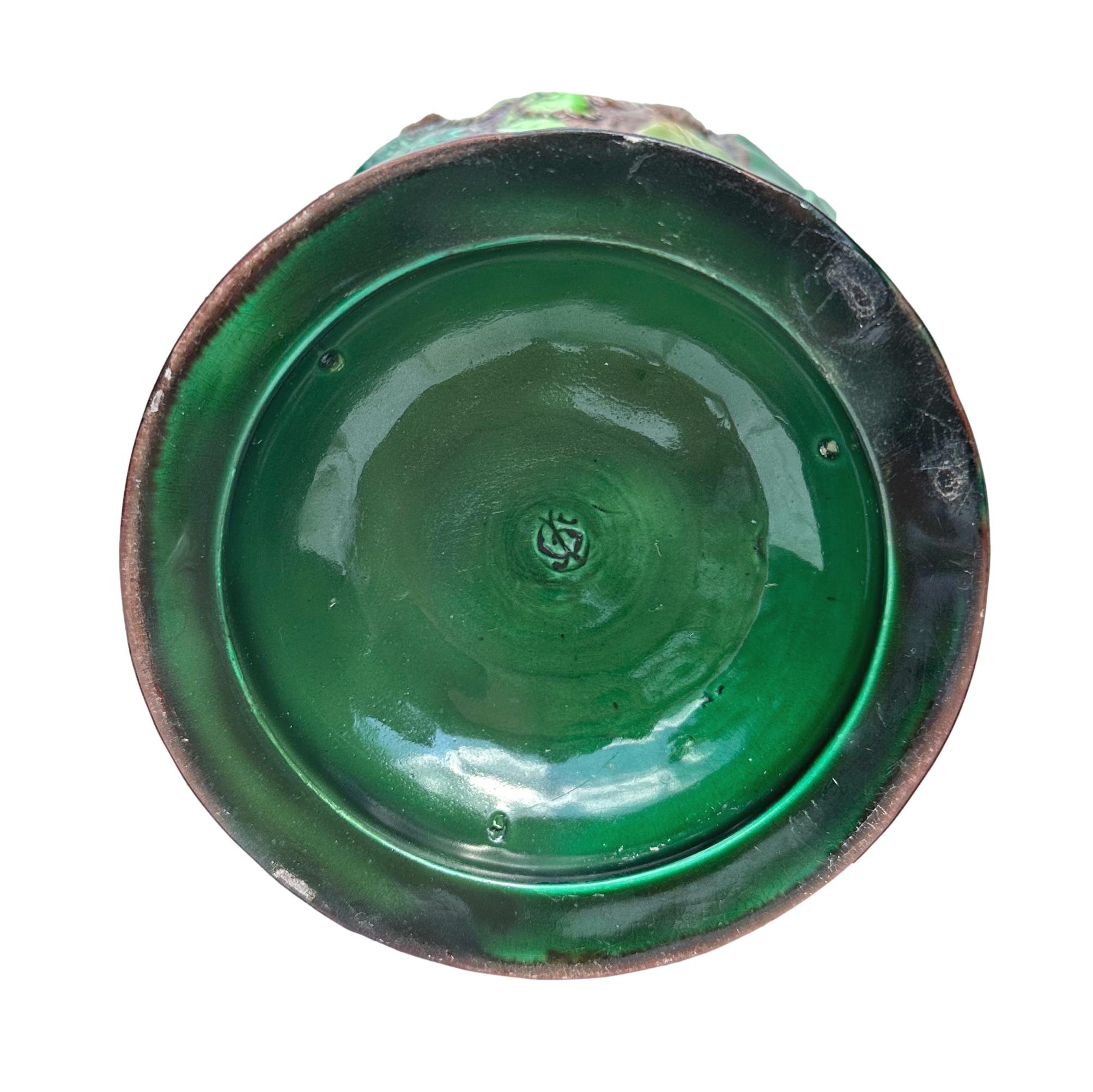 Image 19 of 19
Image 19 of 19

A George Jones Majolica 'Palissy Vase' with Snake Handle, English, ca. 1870
A Highly Important George Jones Majolica 'Palissy Vase,' molded as an obovoid-form ewer, the rustic bark ground with molded green-glazed leaves and ferns, molded and applied with three naturalistic lizards and seashells on a mound-form base encircled by shells, the shaped and flared spout surmounted by a coiled and smiling snake handle, the interior glazed in light blue, the reverse with impressed 'GJ' monogram, English, ca. 1870.
George Jones's inspiration for this design was based on an ewer by the important sixteenth-century French ceramist Bernard Palissy (1509--1590). Rebecca Wallis notes that Minton took inspiration from Palissy wares, and other firms followed:
"For instance, an ewer made by George Jones (1823--1893)--is based on a piece once in the Fountaine collection. Jones's so-called Palissy Vase is brilliantly executed as a faithful copy--yet there is no evidence that he had access to the original. He probably relied instead on the detailed colored illustration published in Monographie de l'oeuvre de Bernard Palissy (see Weber, FIG. 2.9) published in Paris in 1862, and substantive industry experience to create this modern version." (Weber, Vol. 1, p. 42.)
Jones's "modern" version, designed in ca. 1866, was among the firm's first majolica designs. It is less aggressive than the original and has an added element of humor and whimsy, with striking translucent glazes--hallmarks of the best majolica ever made.
We have been among the preeminent specialists in fine English majolica for over thirty years.
BOOK REFERENCES:
Susan Weber, Rebecca Wallis, et al., MAJOLICA MANIA: Transatlantic Pottery in
England and the United States 1850--1915. New Haven and London: Yale
University Press, 2020, volume 1, p. 43. (Figures 2.1. and 2.9.)
Nicholas M. Dawes, MAJOLICA. New York: Crown Publishers, Inc., 1990, p. 39.
(Figures 59 and 60.)
Sotheby’s, ENGLISH MAJOLICA FROM A PRIVATE COLLECTION. New York:
sale number 6958, March 11, 1997, lot number 123. (For an identical example.)
A Highly Important George Jones Majolica 'Palissy Vase,' molded as an obovoid-form ewer, the rustic bark ground with molded green-glazed leaves and ferns, molded and applied with three naturalistic lizards and seashells on a mound-form base encircled by shells, the shaped and flared spout surmounted by a coiled and smiling snake handle, the interior glazed in light blue, the reverse with impressed 'GJ' monogram, English, ca. 1870.
George Jones's inspiration for this design was based on an ewer by the important sixteenth-century French ceramist Bernard Palissy (1509--1590). Rebecca Wallis notes that Minton took inspiration from Palissy wares, and other firms followed:
"For instance, an ewer made by George Jones (1823--1893)--is based on a piece once in the Fountaine collection. Jones's so-called Palissy Vase is brilliantly executed as a faithful copy--yet there is no evidence that he had access to the original. He probably relied instead on the detailed colored illustration published in Monographie de l'oeuvre de Bernard Palissy (see Weber, FIG. 2.9) published in Paris in 1862, and substantive industry experience to create this modern version." (Weber, Vol. 1, p. 42.)
Jones's "modern" version, designed in ca. 1866, was among the firm's first majolica designs. It is less aggressive than the original and has an added element of humor and whimsy, with striking translucent glazes--hallmarks of the best majolica ever made.
We have been among the preeminent specialists in fine English majolica for over thirty years.
BOOK REFERENCES:
Susan Weber, Rebecca Wallis, et al., MAJOLICA MANIA: Transatlantic Pottery in
England and the United States 1850--1915. New Haven and London: Yale
University Press, 2020, volume 1, p. 43. (Figures 2.1. and 2.9.)
Nicholas M. Dawes, MAJOLICA. New York: Crown Publishers, Inc., 1990, p. 39.
(Figures 59 and 60.)
Sotheby’s, ENGLISH MAJOLICA FROM A PRIVATE COLLECTION. New York:
sale number 6958, March 11, 1997, lot number 123. (For an identical example.)
A Highly Important George Jones Majolica 'Palissy Vase,' molded as an obovoid-form ewer, the rustic bark ground with molded green-glazed leaves and ferns, molded and applied with three naturalistic lizards and seashells on a mound-form base encircled by shells, the shaped and flared spout surmounted by a coiled and smiling snake handle, the interior glazed in light blue, the reverse with impressed 'GJ' monogram, English, ca. 1870.
George Jones's inspiration for this design was based on an ewer by the important sixteenth-century French ceramist Bernard Palissy (1509--1590). Rebecca Wallis notes that Minton took inspiration from Palissy wares, and other firms followed:
"For instance, an ewer made by George Jones (1823--1893)--is based on a piece once in the Fountaine collection. Jones's so-called Palissy Vase is brilliantly executed as a faithful copy--yet there is no evidence that he had access to the original. He probably relied instead on the detailed colored illustration published in Monographie de l'oeuvre de Bernard Palissy (see Weber, FIG. 2.9) published in Paris in 1862, and substantive industry experience to create this modern version." (Weber, Vol. 1, p. 42.)
Jones's "modern" version, designed in ca. 1866, was among the firm's first majolica designs. It is less aggressive than the original and has an added element of humor and whimsy, with striking translucent glazes--hallmarks of the best majolica ever made.
We have been among the preeminent specialists in fine English majolica for over thirty years.
BOOK REFERENCES:
Susan Weber, Rebecca Wallis, et al., MAJOLICA MANIA: Transatlantic Pottery in
England and the United States 1850--1915. New Haven and London: Yale
University Press, 2020, volume 1, p. 43. (Figures 2.1. and 2.9.)
Nicholas M. Dawes, MAJOLICA. New York: Crown Publishers, Inc., 1990, p. 39.
(Figures 59 and 60.)
Sotheby’s, ENGLISH MAJOLICA FROM A PRIVATE COLLECTION. New York:
sale number 6958, March 11, 1997, lot number 123. (For an identical example.)


